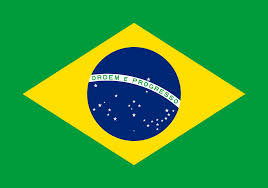BRAZIL
.
.

Trackchasing Country #41
Greetings from places on the way to and from Caruaru, Brazil. Click on the links below to read about the “story” and see the photos and videos from the largest country in South America, Brazil, trackchasing country #41.
“BRAZIL….THE PREPARATION” (part 1 of 3)
Greetings from San Clemente, California
Editor’s note
Everything written in this Trackchaser Report was reported before we ever landed in Brazil. In order for a trip like this to be successful a good deal of work must be done. That planning takes place at the world headquarters of RLR – Randy Lewis Racing in San Clemente, California.

Also, please don’t miss some “background” information on Brazil, the country. It appears at the bottom of this report. I have tried to condense this section so you can get a good “feel” for this South American country. The U.S. State Department offered a good share of “warnings”. That didn’t deter us. We are international trackchasers!
TODAY’S HEADLINES
Advice from the world’s #1 international trackchaser…………..details in “Advance Preparation”.
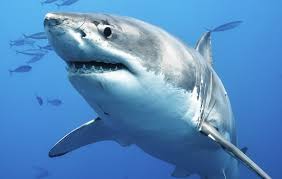
Why would swimming in the hotel pool be better than swimming in the ocean?……………….more in “Overnight Accommodations”.
Who would have thought it would be this time-consuming and expensive to get a Brazilian visa? …………..details in “The Visa”.
ADVANCE PREPARATION
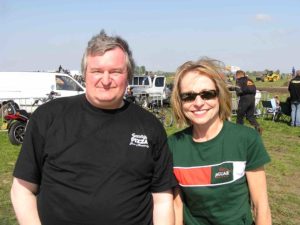
It’s important to listen to others.
I am always willing to listen to others. That’s one of the best ways to get new ideas. However, listening to others does not mean their advice is good or that it should be acted upon. You may know that I am in an “uphill struggle” with fellow trackchasing international competitor Roland Vanden Eynde (above left). He resides in Belgium. Roland has seen racing in 44 countries, 33 of which are in his native Europe.
I have seen racing in “only” 41 countries including this trip to Brazil. I put in tons of planning time on these trips using the latest technological advances and equipment. Up to know I have always found the more time I put into a trip, the better results I get.

However, Roland recently shared some new information in our trackchasing forum regarding trackchasing preparation. He also explained the real “secret” to success when planning trips. I have to be honest. I had never looked at it from Roland’s point of view. Below is an excerpt from Roland’s travel planning theory. Due to space limitations I didn’t use Roland’s entire message. However, I went out of my way to insure the comments I did use were not taken out of context. Here is what Roland wrote:
Was this the real ‘secret’?
“With the internet, anyone who can read and write a bit can draw up a through international race programme in less than two hours, merely by opening all the links Will (Will White, unofficial trackchasing commissioner) has included in his websites. Using a travel aid, such as Rand McNally or Viamichelin, can get one the location of a track and the road to take in order to get there within minutes. And that’s all there is, except for races for which one needs to buy an airline ticket and hire a car. But again, that can also be done in a matter of minutes. No track I ever visited has cost me more than an hour of preparation, those in Belgium and the Netherlands probably a mere five minutes. Successful trackchasing really depends on luck (discovering it in schedules and it being active when one is able to attend), and luck alone.”
Wow!
That’s right. Wow! You can imagine how surprised I was to get this advice on international track planning! These “secrets” were coming from the man who has seen racing in more countries (so far) than anyone else. According to Roland, “no track I have ever visited cost me more than an hour of preparation”. Oh, my! What had I been missing? I have been busting my butt, using every piece of technology that my meager budget can afford and all along the real secret to success was…..luck? How could I have missed that?
At this point, I am almost ashamed to admit that just getting a “travel visa” to Brazil for this trip took me a minimum of SEVEN hours. On top of that I had to pay $260 for Carol and me so we could even get a visa. I didn’t consider myself “lucky” to have to pay that much money or spend that much time just to get a visa.

Was I upset or confused or both?
I was both upset and confused. Had I been wasting my time all these years by being so inefficient in the planning process? All this time should I have just counted on “luck” to get me through? I didn’t know what to think.
I continued to ponder the possibilities. What if Roland’s objective was to simply confuse me? What if he feared losing the international trackchasing lead to me? Would he try to through me off my routine of the six “Ps” (Proper planning prevents piss poor performance)?
Some of those fellas in the trackchasing group can be a bit on the sneaky side. I’ve seen folks “say” that this isn’t a competition and then do their level best to “beat the other guy” by traveling long distances and spending huge sums of money just to “pad their totals”. I’ve even seen Roland do it. I just didn’t know what to think.
I truly did spend seven hours (or more) getting a Brazilian visa. As I think back on it, I don’t think I could have done it in less time. As you’ll see below, every other planning aspect of this trip took a good deal of time and effort to complete. All of THAT time doesn’t even include the TRAVEL time required to make this trip a success. Heck, we would spend nearly 48 hours of round-trip travel time just getting to and from our destination in Brazil. Honestly, I just didn’t know what to think about Roland’s theories on implementing a complete international trackchasing plan and race.

Roland says that the preparation for his local trips takes about five minutes “No track I ever visited has cost me more than an hour of preparation, those in Belgium and the Netherlands probably a mere five minutes”. I either need to hire him to do my domestic track planner or take him to Las Vegas with me since he seems to be “luckier” than me.
This is a real life example.
Here’s an example of the time it took me to pull off a recent domestic race date. You’ll have to decide if the trip’s success was based upon luck or the ability to analyze the data provided by the technology tools I have in my trackchasing toolbox. Mind you it gets a little detailed reading about what happened. Imagine the detail it took to plan it and then actually DO it.
A couple of weeks ago I was in Texas trackchasing. I had race dates planned for Friday and Saturday. However, I couldn’t find any track that was racing on Sunday in Texas. It seemed a shame to travel back home without trying to find somewhere that was racing on Sunday.

Then all of a sudden I got “lucky”. I found a track called I-35 Kartway that was racing on the Sunday. Every event on their schedule for 2010 runs on a Saturday night except for this sole Sunday afternoon race date. They happened to be racing on a Sunday while I was in Texas and badly in need of a Sunday race. Boy, was I “lucky”.
Then I began to think about the “luck” factor in all of this. Maybe it hadn’t been luck that brought me to the I-35 Kartway on the one and only Sunday they were racing all year. You be the judge. Here’s what actually happened.
Do you spend Saturday mornings doing stuff like this?
I spent all Saturday morning in an Odessa, Texas Motel 6 using my laptop to scan the schedules of the remaining 22 Texas tracks that I have not seen up to now. I was searching for a track that might be racing on Sunday. With technology I am what is called an “early adopter”. I get machines far in advance of when most people are willing to try and buy the stuff. I have my kids, mainly J.J., to thank for that. Sometimes they “shame” me into being an early adopter!
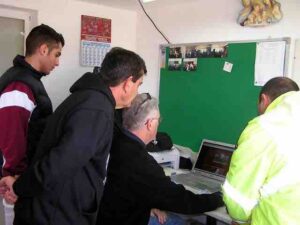
Nevertheless, I was the first trackchaser to carry a laptop with me on trackchasing trips. I was the first trackchaser to have “anywhere/anytime” laptop internet capability. To this day, there are only a handful of trackchasers who would be able to access every track’s website in an entire state..…….from their motel room.
Once I saw that the I-35 Kartway was racing on Sunday I had to confirm the classes they ran would be “countable” under our current trackchasing rules. This track raced go-karts and not all go-karts count in trackchasing. I emailed and also phoned the contacts listed on I-35 Kartway website. Heck, it wasn’t that many years ago, when I was the only trackchaser using a cell phone on the road. To the I-35 Kartway’s credit, they promptly returned both my email message and phone call. Most tracks wouldn’t do that.

I carry a computer in my front pocket.
Only about 5% of my Apple iPhone usage is for phone calls. In point of fact, my iPhone is much more useful than my laptop. For the I-35 Kartway trip, I used the iPhone to check my weather “app”. I had to confirm the weather was good enough to make the Sunday trip. The weather was good.
Then while I was in route, I used my iPhone “app” to access the United Airlines website. Since this Sunday track would require a change in airline plans, I needed to confirm there would be standby seats available for a flight leaving the next day. There were seats. I made an airline reservation from my car while traveling down a Texas highway at 70 M.P.H.
The “new” Sunday plan meant that I would need another day of rental car. My best option was to drop that car in Dallas rather than Odessa where I had picked up the car I was currently driving. I would need to get an entirely new car and use it as a one-way rental. Of course, this required multiple phone calls, while driving, to get all the loose ends tied up.
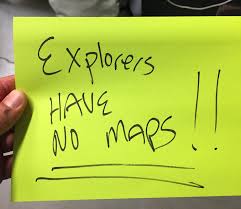
No paper for me.
I don’t carry paper roadmaps with me. Despite Roland’s recommendation, I find them too confining. I used the “maps” app on my iPhone. By the way, my iPhone is about 1/3 the size of a deck of playing cards. It doesn’t take up much room compared to a complete Rand McNally Road Atlas.
I needed to find out if there was enough time to make the drive from Odessa, Texas to the I-35 Kartway in Lorena, Texas on Sunday. The trip would be more than 300 miles from my hotel to the track. The racing program began at 3 p.m. However, the National car counter didn’t open until 9 a.m. on Sunday morning. There wouldn’t be much time to change cars. Given those parameters I might have a hard time getting to the track on time.
More phone calls told me that National’s “sister” company Enterprise opened at 7:30 a.m. a full 90 minutes earlier than National’s Sunday morning opening time. Still more phone calls to managers at Enterprise convinced them to close out a National contract and give me a National car. It was something the Enterprise people said they had never done.
I still didn’t have too many moments to spare. Did I waste my time reading road maps with the potential to get lost or take a less than optimum route? Nope! I simply pulled out of the Odessa airport and “Garth” my loyal and ardent GPS partner did the rest. As I traveled along rural two-lane Texas roads, Garth continually updated me on my expected arrival time. As I began to “gain” on things, I found I had an extra 15 minutes to stop at a local Texas festival.
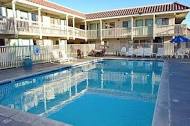
During this drive, I made a call to Motel 6 to secure a room for Sunday evening. Of course, my iPhone has the Motel 6 reservation number preset, along with about 1,000 (one-thousand) other numbers of equal value. With Motel 6, I give them my name and phone number. That’s it. All of the other information is “in the system”. The reservation process takes less than a minute.
During downtimes at the racetrack I use my iPhone to read the USA Today newspaper “app” from front to back. I text messaged the family back home to let them know how I was doing. Then I used my iPhone to take pictures of the I-35 Kartway. From the track, I emailed those photos from my iPhone to trackchasing’s commissioner Will White. This way he has the very latest information on how many tracks I’ve seen. I would guess that Will is updated on my current track count earlier via this system than he is from any other trackchaser.
On the ride back to the hotel on Sunday evening I was getting hungry. If I wanted to eat at a Subway or a Waffle House or anywhere else, I could just punch in a number or two and “Garth” will immediately offer turn-by-turn audio directions so I don’t miss a meal. When it’s time to get up in the morning, I have dozens of ringtones I can choose from my iPhone alarm clock to get me going. I can download my airline boarding pass information into my iPhone. At the airport, I show the TSA security agent the airline information DIRECTLY from my iPhone. There’s no paper boarding pass at all.
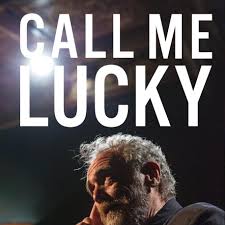
Now we get back to the original question.
Now we get back to the original question in the example I provided. Was I “lucky” to find a track racing on a Sunday in Texas and then get to it? Somehow, I don’t think it was luck. I ended up driving an extra 482 miles in 15 hours to get that track. I incurred an extra night away from home and a night’s hotel expense getting that track. Without a laptop, an iPhone and a GPS unit there’s not another trackchaser in the business who could have pulled off what I did.
Some folks don’t know what they don’t know.
Do I think Roland is insincere in his analysis that “luck” is the primary driver when it comes to successful trackchasing? No, I do not. Do I think that Roland may be suffering from a case of “he doesn’t know what he doesn’t know”? Yes, I do. It’s most difficult to understand the latest machines when you’ve never worked with them. It’s nearly impossible to appreciate their benefits when you’ve never used many of the machines or strategies. It’s somewhat like saying to a surgeon, “What do you need all of those instruments for? Just reach in there and grab that appendix”.
I guess I’ll go back to what I said at the top of this report. I will “listen” to everyone. However, not all advice is of the same quality. Everyone’s advice can’t be heeded. Gary Player, the professional golfer once said, “The harder I work, the luckier I get”. That’s the philosophy I live my life by.

Am I running out of trackchasing countries?
That’s always a good question to begin with. I have trackchased in 40 countries before this trip. There has been trackchasing in a total of just 60 countries. There aren’t many countries in addition to those 60 that even have auto racing. Actually some of those 60 countries where trackchasing has taken place don’t even exist anymore!! I’ll comment more on that at a future time. Even though this is a very big world we live in, there really aren’t that many trackchasing countries for me to pick from at this point.
Secret international agents rule!
I am “tuned in” to the international racing scene via “agents” across the world. I think it’s safe to say I have more helpers stashed in every corner of this world than any other trackchaser. I am eternally grateful to each and every one of those folks. Those “agents” are the reason that I and my “trackchasing companion” showed up in Brazil this week. Let me give you some of the background on how this happened.
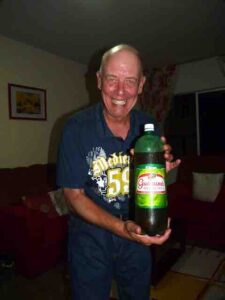
An invitation from Jerry Fisher.
I was quietly sitting in my office playing on my laptop as I am wont to do. This was late last fall. Up popped an email from Jerry Fisher. Jerry is a retired English postal manager. I first became aware of Jerry via Rick Young. Rick is a relocated Englishman (to Canada). Rick’s a race fan and has a wonderful website (www.rickattheraces.net) He’s also a former stock car driver in the U.K. who now specializes in racing photography, mainly in Ontario and surrounding areas in the northeast.
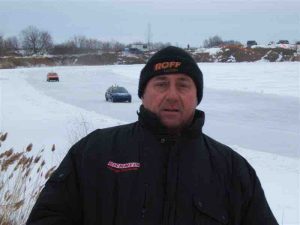
Rick and I first met back in 1999 at the Cornwall Motor Speedway in Ontario, Canada. I had just finished up one of my racetrack “media” interviews. In a way, I guess I could rightfully say I never would have trackchased in Brazil if I weren’t constantly doing these interviews. Anyway, Rick came up to say hello briefly. Since then we’ve met at different racetracks along the way. Carol and I even had the pleasure of having dinner with Rick, an option I reserve for a select few racing friends.
One of Rick’s friends from England is Jerry Fisher. I found out that, after retirement, Jerry was living in Argentina. Yes, this is a true international saga. After some correspondence and a phone call with the gregarious Mr. Fisher, he convinced me to fly down to Buenos Aires, Argentina for some midget racing. Other than New Zealand, the race in Argentina was the furthest south in the world that I had ever trackchased.
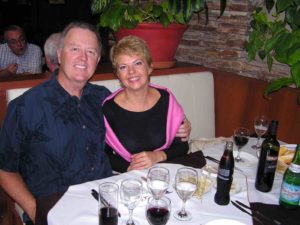
During the trip to Buenos Aires I spent a good deal of time with Jerry and his wife Elena (above). Elena is a native of Russia. Before she left her homeland she was an attorney. As I departed they both reminded me that they planned to relocate from Argentina to Brazil. Then they invited me to join them there for a future race activity there. That trip seemed like a long time ago. Actually it was just 16 months ago. Argentina was trackchasing country #24.
From that point, I didn’t give Brazil very much thought. However, when Jerry invited me down to his “new” home country, I couldn’t pass up the chance to visit. Carol and I would spend six days in Brazil. It never would have happened without the support of my “international agents”!!
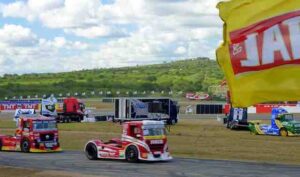
THE RACE
Jerry Fisher came up with the race idea. We would be seeing the Brazilian Formula Trucks race at a track in Caruaru, Brazil. The track would be a two-hour drive from where we would stay in Recife, Brazil. Heck, I was looking forward to the drive over there as much as I was seeing the race.
Having Jerry with me in Argentina was a MAJOR plus. I figured his local knowledge and being able to speak to him about it in ENGLISH would be the cherry on the top of this trackchasing sundae. I’ll tell you more about the race in the third and final part of my Brazilian Trackchaser Report.
THE VISA
For most of the foreign countries I visit there is no need to even get a visa. That is not the case for Brazil. Getting a travel visa to Brazil turned out to be a real chore for Carol and me. First, I had to negotiate a less than friendly Brazilian consulate website. I’ll bet it took me well over an hour to figure out where on the website the “application” was and then more time to fill out their PDF file.
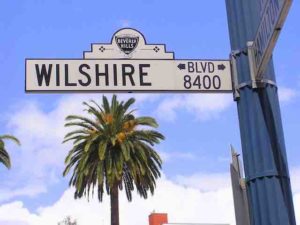
You might think (or Roland might think) the process was over. Just mail in the application and get your visa. Nope! It was not going to be that simple. Not even close! First, we had to make an appointment on line. The consulate is only open from 9 a.m. to 12 p.m. each day of the workweek. The nearest Brazilian consulate to us is located on Wilshire Blvd. in Beverly Hills, California. That sounds like the life to me. Stay open for just three hours and then go shopping all afternoon in Beverly Hills!
They weren’t going to make this easy.
Of course, Beverly Hills is about a one and a half hour drive from our house (more with rush hour traffic). That meant we would be investing a minimum of three hours just “dropping off our visa application”. We even had to make an appointment to drop off our application! Are you kidding me?? Before we could complete the application we had to go to our local AAA auto office and get “passport photos” taken for our Brazilian visa. This was really getting time consuming and it would get very expensive soon. At one point, I figured I might just use one of the other Brazilian consulates in the U.S. if I happened to be “in the area” on one of my other trackchasing U.S. trips. Nope! If you live in California you MUST go through the Los Angeles area consulate. You can’t go anywhere else.
As you know, I’ve been traveling internationally, on average, every month for almost three years. In order to get a Brazilian visa Carol and I had to give our passport to the Brazilian authorities for a minimum of “ten working days”. That might not seem like a problem to most people but it was inconvenient for us. Then they had the gall to say there was no guarantee we would even be approved for a visa.
It’s always about the money isn’t it.
You might think the above “rigamarow” was just a bit too much. You don’t know the half of it. There was a “fee” to get a Brazilian visa. What might be a reasonable fee? I was thinking ten bucks, maybe twenty-five bucks. These Brazilian bandits wanted $130 from BOTH Carol and me. That’s a total of $260. My first car only cost me (really my parents) $170. I would surely rather have that 1955 Pontiac Chieftain back than two measly Brazilian visas.
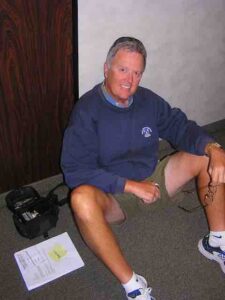
We were good to go?…..not quite.
Nevertheless, we did all of the above. I figured when they finished they would simply mail our passports back to us and we would be “good to go”. Not quite! We were REQUIRED to drive back up to Beverly Hills to personally pick up our passports. To top all of that off, they are only open ONE HOUR each day for people to pick up their visas! We did catch a break with this requirement. They would allow me to pick up both of our passports. Carol would not have to waste another three hours sitting in traffic just to pickup her passport.
You can’t start this process too early and you can’t start it too late.
There you have it. We spent a minimum of seven hours physically getting a Brazilian visa. We spent $260 for the privilege. Our timing had to be just right too. When you receive your visa you must use it within 90 days of getting it. Therefore, you can’t start the process too early or you can’t use the visa. You can’t start the process to late or you won’t get a visa. Maybe Roland’s advice on just being “lucky” would have been a better choice than following all of the rules set down by the Brazilian government to get their #$^%^## visa.
THE TRANSPORTATION
Although I have not seen racing in the most countries according to www.autoracingrecords.com, (yet anyway) I have easily traveled more miles than any other trackchaser in search of international trackchasing venues by a factor or more than two. I don’t mind the travel a bit. It’s part of the adventure.
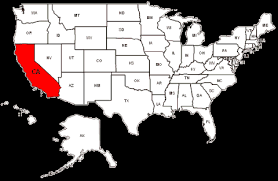
What’s the California ‘travel penalty’?
When this trip is complete I will have seen auto racing in 41 countries. Except for the United States I have flown to EVERY ONE of the remaining 40 countries. That’s the “California travel penalty” one gets from residing in the United States and trying to compete on an “international playing field”.
This trip was like any other flying trip, domestic or otherwise, in one regard. I had three sources for airline tickets. I could use my airline sponsors. I could use a frequent flyer ticket, or I could buy a ticket. Carol and I are “retired folks”. Actually buying an airline ticket ranks third amongst the above three choices.
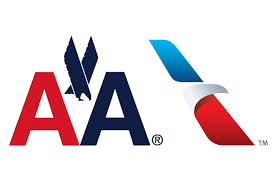
My primary airline sponsors don’t fly to Recife, Brazil. That left just one choice….use a frequent flyer ticket on American Airlines to get there. “Back in the day” I flew nearly every week on American. That’s right. For the past 20 years of my career I accrued “miles” on American Airlines nearly every week. I’ve been retired for almost eight years. I still have “tons” of frequent flyer miles. I spent a lot of late nights in those cramped airline seats flying back to California after a weeklong series of meetings. I EARNED those miles. Now, I spend them as wisely as I would if I were spending cash.
I’m not sure what timesaving features Mr. Vanden Eynde uses to buy his airline tickets. He did state previously that he spent $1,500 on an airline ticket to see a race in South Africa. I’m retired. We live on a modest income of IRA withdrawals. I might not spend that much money on five trips.
However, in order to get the right connections at the right prices, it takes time to explore all the alternatives. I’ll spend hours planning just a single trip. I’m shooting for the most time efficient and cost-effective option I can find. My experience has been the more time I put into the planning effort, the bigger benefit I get. When I can’t see any more benefit coming my way, I don’t put any more time in.

TIME ZONES
Recife, Brazil is just four hours ahead of our time zone (Pacific Daylight Savings) in California. Like Chile, I will be traveling just about as far south as I am east. Handling a four-hour time change won’t be much different than being at home.
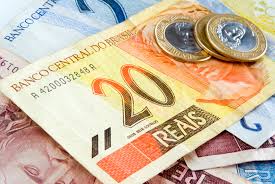
CURRENCY
Since 1994, Brazil has used the Brazilian Real (plural Reais). The currency symbol is R$. My iPhone currency “app” tells me that one U.S. dollar buys R$1.7744. Editor’s note: In 2017 one U.S. dollar will get you R$3.17. Our bank doesn’t handle Brazilian currency. That means we’ll have to use an ATM or money exchange office when we arrive. Carol does have two traveler’s checks from the Civil War. We’ll try to unload those if we can as well.
WEATHER
My Apple iPhone weather “app” told me it will be in the mid to high 80s during our six days in Recife. The app also offered rain forecasts of between 0-60%. This advance information, from one of the best pieces of technology ever created, will help us pack the right clothes for the trip.
OVERNIGHT ACCOMMODATIONS
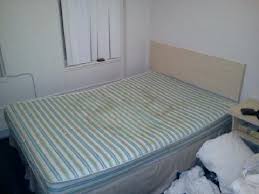
I do it for Carol.
Last week in Oklahoma, I stayed in the most decrepit Knights Inn they likely have in their chain. The next night I stayed in a Motel 6 that advertised that “criminal behavior” would not be tolerated and the property was patrolled by the Tulsa Police department. The next night I was prepared to sleep on the floor of the Denver airport if just three more people has shown up to bump me off my flight back home. I view the above as a “financial sacrifice” for Carol. When she travels we go first class. When I travel by myself, I’m willing to put myself in “harm’s way if necessary” in order to “meet the budget”.
Jerry Fisher gave me a good recommendation on a place to stay in Recife, Brazil. He recommended the Dorisol Recife Grand Hotel. Somehow that just had a “better ring to it” than the Motel 6. I had only met Jerry on one previous occasion. I didn’t know him all that well, but he did impress me as an “upscale” fellow. I liked his idea. I did a little research on his recommendation.
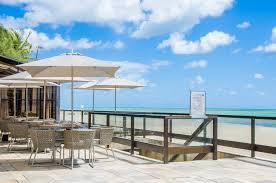
I found that the Dorisol Grand Hotel was a wonderful place. It is one of only two five-star hotels in Recife. Carol would like a place like that wouldn’t she? I sure hope so. I booked five nights there!
I love reading “user reviews”.
Of course, even working with a recommendation from Jerry Fisher, this was not a process to be completed in five minutes. First, I “price-shopped” the property over multiple websites. Then I spent several minutes reading “user reviews” on what people liked about this property and what they didn’t. I will say this. It looks to me like many people who take the time to write reviews are of the “whiner” variety. Here are a few samples:
“We were on the damn 11th floor! I actually started crying being so far away from home and feeling like I had to stay in a {–} hotel.”
Randy’s comment: What kind of fella would start crying over having to stay on the 11th floor?
“Good hotel in a magnificent site. The hotel has an excellent breakfast. Apartment spacious and clean. Staff friendly.”
Randy’s comment: Our room rate includes breakfast!
“The beach is quite nice, and apparently safe from the sharks that infest the municipal beaches closer to downtown Recife.”
Randy’s comment: I’ll think we’ll stick to the pool.
“Try for room #08, 09, 10, or 11 on any floor for the best view”.
Randy’s comment: Only with the proper amount of research time will critical information like this be found. Of course, getting the very best view can make your hotel stay more enjoyable. Now I was really puzzled. Roland does all of the stuff I’m telling you about in just one hour? Wow!
THE RENTAL CAR
This was a tough call. Jerry recommended no rental car and taking a taxi to the racetrack on race day. I take all local advice and consider it. However, this was not my first rodeo. I’m from California and we are the “car culture” capital of the world. Having a car gives us “independence”. I’m sure we’ll take cabs to restaurants in the evening. Rental cars aren’t too expensive in Brazil so just having a car for outings for 2-3 days will make it worth having one. A car lets us explore on our terms. I like that.
NAVIGATION
“Garth”, my GPS unit, won’t be making this trip with me. He doesn’t speak Portuguese. I doubt I’ll rent a GPS locally either. I’ll just plan on having more time being lost. Actually being lost isn’t really that bad. We see some interesting sights that way.

THE TRAVELING COMPANION
When I used to take “aptitude” tests back in high school and college I always scored well on “persuasion”. Maybe that’s why I became a salesman. Nevertheless, I had to use all of my persuasive techniques to get Carol to travel to Morocco last week, come back to California this week and leave eight days later for Brazil. Even I wasn’t that wild about making two major international trips with only eight days in between. However, in this situation, it was the best we could do.
This ‘preparation’ really took some time.
Talk about preparation time for a trip. You can’t imagine all of the time I spent in my office just trying to think of the right words to use to convince Carol that this would be a good idea. The sweat was rolling off my brow as I discarded one sales pitch after another. Mr. Vanden Eynde rarely travels with a companion. I do know this. When I travel with Carol my “prep time” increases substantially. I’m not just trying to please myself, I’m trying to make sure “Trackchasing’s First Mother” has the very best time possible. Of course, this “task” is a labor of love.

THE SUMMARY
During the last four and one-half months my travel schedule has been daunting. I’ve made separate trips to Malta, Canada, Finland, Japan, Chile, Morocco and now Brazil. When will this all stop? I hope it continues forever…..but I know it won’t. Nevertheless, I’ll keep doing this until it stops being fun. Remember, that’s the overriding objective of EVERY trip….to have fun.

To be continued………………….
Thanks for reading about my trackchasing,
Randy Lewis
Alberta’s #1 Trackchaser
Brazilian saying: If it were ever to rain soup, the poor would only have forks.
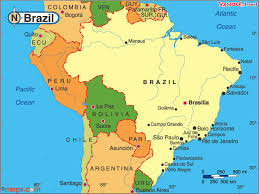
BRAZIL – FAST FACTS*
Brazil, officially the Federative Republic of Brazil, is the largest country in South America and the only Portuguese-speaking country in the Americas. It is both the world’s fifth largest country by geographical area and by population. Bounded by the Atlantic Ocean on the east, Brazil has a coastline of over 7,491 kilometers (4,655 mi). It is bordered on the north by Venezuela, Guyana, Suriname and the French overseas department of French Guiana; on the northwest by Colombia; on the west by Bolivia and Peru; on the southwest by Argentina and Paraguay and on the south by Uruguay.
Brazil is the world’s eighth largest economy by nominal GDP and the ninth largest by purchasing power parity. Economic reforms have given the country new international recognition.
HISTORY
The land now called Brazil, was claimed by Portugal in April 1500. Colonization was effectively begun in 1534. By the mid 16th century, sugar had become Brazil’s most important export and the Portuguese imported African slaves to cope with the increasing international demand. At the end of the 17th century, sugar exports started to decline but the discovery of gold by explorers in the region saved the colony from imminent collapse. From all over Brazil, as well as from Portugal, thousands of immigrants came to the mines. Slavery was extinguished after a slow but steady process that began with the end of the international traffic in slaves in 1850 and ended with the complete abolition of slavery in 1888. In 1823, 29% of the Brazilian population were slaves but by 1887 this had fallen to 5%.
In the 1920s the country was plagued by several rebellions caused by young military officers. In 1935 Communists rebelled across the country and made an unsuccessful bid for power. Brazil remained neutral during the early years of World War II until the government declared war against the Axis powers in 1942.
GOVERNMENT AND POLITICS
The Brazilian Federation is the “indissoluble union” of three distinct political entities: the States, the Municipalities and the Federal District. Voting is compulsory for the literate between 18 and 70 years old and optional for illiterates and those between 16 and 18 or beyond 70. Four political parties stand out: Workers’ Party (PT), Brazilian Social Democracy Party (PSDB), Brazilian Democratic Movement Party (PMDB), and Democrats (DEM). Fifteen political parties are represented in Congress. It is common for politicians to switch parties, and thus the proportion of congressional seats held by particular parties changes regularly.
FOREIGN RELATIONS AND MILITARY
Brazil is a political and economic leader in Latin America, however, social and economic problems prevent it from becoming an effective global power. The armed forces of Brazil consist of the Brazilian Army, the Brazilian Navy, and the Brazilian Air Force. With a total of 371,199 active personnel, they comprise the largest armed force in Latin America.
STATES AND MUNICIPALITIES
Brazil is a federation composed of twenty-six States, one federal district (which contains the capital city, Brasília). States have much less autonomy to create their own laws than in the United States. For example, criminal and civil laws can only be voted by the federal bicameral Congress and are uniform throughout the country.
GEOGRAPHY
Brazil is the fifth largest country in the world, after Russia, Canada, China and the United States. It spans three time zones. Brazil has a dense and complex system of rivers, one of the world’s most extensive, with eight major drainage basins, all of which drain into the Atlantic.
CLIMATE
The climate of Brazil comprises a wide range of weather conditions across a large area and varied topography, but most of the country is tropical. An equatorial climate characterizes much of northern Brazil. There is no real dry season, but there are some variations in the period of the year when most rain falls. South of Bahia, near São Paulo, the distribution of rainfall changes, with rain falling throughout the year . The south enjoys temperate conditions, with cool winters and average annual temperatures not exceeding 18 °C (64.4 °F); winter frosts are quite common, with occasional snowfall in the higher areas.
FLORA AND FAUNA
Brazil’s large territory comprises different ecosystems, such as the Amazon Rainforest, recognized as having the greatest biological diversity in the world. The rich wildlife of Brazil reflects the variety of natural habitats. Much of it, however, remains largely undocumented, and new species are regularly found. Scientists estimate that the total number of plant and animal species in Brazil could approach four million. Larger mammals include pumas, jaguars, ocelots, rare bush dogs, and foxes; peccaries, tapirs, anteaters, sloths, opossums, and armadillos are abundant. Deer are plentiful in the south, and many species of New World monkeys are found in the northern rain forests.
ECONOMY
Brazil is the largest national economy in Latin America, the world’s tenth largest economy at market exchange rates. Its current GDP (PPP) per capita is $10,200, putting Brazil in the 64th (world) position. Brazilian exports are booming, creating a new generation of tycoons. Major export products include aircraft, electrical equipment, automobiles, ethanol, textiles, footwear, iron ore, steel, coffee, orange juice, soybeans and corned beef.
Brazil pegged its currency, the real, to the U.S. dollar in 1994. Brazil received an International Monetary Fund rescue package in mid-2002 of $30.4 billion, then a record sum. Brazil’s central bank paid back the IMF loan in 2005, although it was not due to be repaid until 2006. The recent economic strength has been due in part to a global boom in commodities prices with exports from beef to soybeans soaring. A global power in agriculture and natural resources, Brazil experienced tremendous economic growth over the past three decades. It is expected to become a major oil producer and exporter, having recently made huge oil discoveries.
DEMOGRAPHICS
The population of Brazil, as recorded by the 2008 PNAD, was approximately 190 million. Brazil’s population increased significantly between 1940 and 1970, due to a decline in the mortality rate, even though the birth rate underwent a slight decline. According to the National Research by Household Sample (PNAD) of 2008, 49,4% of the population (about 92 million) described themselves as White; 43.80% (about 83 million) as Brown (Multiracial), 6.84% (about 13 million) as Black; 0.58% (about 1.1 million) as Yellow; and 0.28% (about 536 thousand) as Amerindian, while 0.07% (about 130 thousand) did not declare their race. Most Brazilians descend from the country’s indigenous peoples, Portuguese settlers, and African slaves.
In 2008, the illiteracy rate was 11.48% and among the youth (ages 15–19) 1.74%. It was highest (20.30%) in the Northeast, which had a large proportion of rural poor. Roman Catholicism is the country’s predominant faith. Brazil has the world’s largest Catholic population. According to the 2000 Demographic Census (the PNAD survey does not inquire about religion), 73.57% of the population followed Roman Catholicism; 15.41% Protestantism; 1.33% Kardecist spiritism; 1.22% other Christian denominations; 0.31% Afro-Brazilian religions; 0.13% Buddhism; 0.05% Judaism; 0.02% Islam; 0.01% Amerindian religions; 0.59% other religions, undeclared or undetermined; while 7.35% have no religion. The largest metropolitan areas in Brazil are São Paulo, Rio de Janeiro, and Belo Horizonte — all in the Southeastern Region — with 19.5, 11.5, and 5.1 million inhabitants respectively. By the way, Recife, where we stayed on this trip is Brazil’s ninth largest city.
LANGUAGE
The official language of Brazil is Portuguese, which is spoken by almost all of the population and is virtually the only language used in newspapers, radio, television, and for business and administrative purposes. Brazil is the only Portuguese-speaking nation in the Americas, making the language an important part of Brazilian national identity and giving it a national culture distinct from those of its Spanish-speaking neighbors.
CRIME
In 2006 nearly 50,000 people were murdered in Brazil. More than 500,000 people have been killed by firearms in Brazil between 1979 and 2003, according to a United Nations report.
CULTURE AND CUISINE
The core culture of Brazil is derived from Portuguese culture, because of its strong colonial ties with the Portuguese empire. Among other influences, the Portuguese introduced the Portuguese language, Roman Catholicism and colonial architectural styles. The culture was, however, also strongly influenced by African, indigenous and non-Portuguese European cultures and traditions.
Brazilian cuisine varies greatly by region, reflecting the country’s mix of native and immigrant populations. This has created a national cuisine marked by the preservation of regional differences. Examples are Feijoada, considered the country’s national dish; and regional foods such as vatapá, moqueca, polenta and acarajé. Brazil has a variety of candies such as brigadeiros (“brigadiers”) and beijinhos (“kissies”). The national beverage is coffee and cachaça is Brazil’s native liquor. Cachaça is distilled from sugar cane and is the main ingredient in the national cocktail, Caipirinha.
The most popular sport in Brazil is football (soccer). The Brazilian national football team is ranked among the best in the world according to the FIFA World Rankings, and has won the World Cup tournament a record five times. Basketball, volleyball, auto racing, and martial arts also attract large audiences. In auto racing, Brazilian drivers have won the Formula One world championship nine times. The São Paulo circuit, Autódromo José Carlos Pace, hosts the annual Grand Prix of Brazil. São Paulo organized the IV Pan American Games in 1963, and Rio de Janeiro hosted the XV Pan American Games in 2007. On 2 October 2009, Brazil was selected to host the 2016 Olympic Games, the first to be held in South America.

BRAZIL – U.S. STATE DEPARTMENT – FAST FACTS
ENTRY / EXIT REQUIREMENTS
A passport and visa are required for U.S. citizens traveling to Brazil for any purpose. Brazilian visas must be obtained in advance from the Brazilian Embassy or consulate nearest to the traveler’s place of residence. There are no “airport visas” and immigration authorities will refuse entry to Brazil to anyone not possessing a valid visa. All Brazilian visas, regardless of the length of validity, must initially be used within 90 days of the issuance date or will no longer be valid.
SAFETY AND SECURITY
Political and labor strikes and demonstrations occur sporadically in urban areas and may cause temporary disruption to public transportation. Colombian groups have perpetrated kidnappings of residents and tourists in border areas of Colombia’s neighbors. Therefore, U.S. citizens traveling or residing in areas of Brazil near the Colombian border are urged to exercise caution. Brazil’s beaches can pose a threat to the safety of U.S. citizen travelers. Very strong and dangerous riptides are encountered in many beaches, including those in Rio and Fortaleza. Additionally, there is a higher-than-average probability of shark attacks in the waters of many of the beaches in northeastern Brazil, including those in Recife, Natal, and Maceio.
The U.S. Embassy restricts travel of U.S. government employees where narcotics traffickers and other criminals have recently resorted to violent actions, usually directed against local security forces, local government authorities, and some civilians. These areas include all favelas in Recife.
CRIME
Crime throughout Brazil has reached very high levels. The Brazilian police and the Brazilian press report that the rate of crime continues to rise, especially in the major urban centers – though it is also spreading in rural areas. Brazil’s murder rate is more than four times higher than that of the U.S. Street crime remains a problem for visitors and local residents alike, especially in the evenings and late at night. Foreign tourists are often targets of crime and Americans are not exempt. This targeting occurs in all tourist areas but is especially problematic in Sao Paulo, Rio de Janeiro, Salvador and Recife. Travelers are advised to keep a copy of their passport on them when in public and, where possible, to keep their passport in a hotel safe or other secure place. Besides a copy of their passport, U.S. citizen travelers are advised to carry proof of whatever health insurance they may have.
Caution is advised with regard to nighttime travel through more rural areas and satellite cities due to reported incidents of roadside robberies that randomly target passing vehicles. Robbery and “quicknapping” outside of banks and ATM machines are common. In a “quicknapping,” criminals abduct victims for a short time in order to receive a quick payoff from the family, business or the victim’s ATM card. Some victims have been beaten and/or raped. Carjacking is on the increase in Sao Paulo, Rio de Janeiro (and) Recife.
The incidence of crime against tourists is greater in areas surrounding beaches, hotels, discotheques, bars, nightclubs, and other similar establishments that cater to visitors. This type of crime is especially prevalent prior to and during Carnaval (Brazilian Mardi Gras), but takes place throughout the year. While the risk is greater at dusk and during the evening hours, street crime can occur both day and night, and even safer areas of cities are not immune. Incidents of theft on city buses are frequent. At airports, hotel lobbies, bus stations and other public places, incidents of pick pocketing, theft of hand carried luggage, and laptop computers are common. Very poor neighborhoods known as “favelas” are found throughout Brazil. The conditions in favelas vary widely, but these areas are often sites of uncontrolled criminal activity and are often not patrolled by police. U.S. citizens are advised to avoid these unsafe areas.
RECIFE
Deceptively tranquil, Recife now has one of the highest per capita murder rates in all of Brazil. As in Rio de Janeiro, tourists in Recife should take special care while on the beaches, as robberies may occur in broad daylight. In the upscale Boa Viagem neighborhood, carjackings can occur at any time of the day or night.
MEDICAL FACILITIES AND HEALTH INFORMATION
Medical care is generally good, but it varies in quality, particularly in remote areas, and it may not meet U.S. standards outside the major cities. A language barrier may exist, particularly with non professional staff lacking English skills. Yellow fever is not currently thought to be a risk for travel to major coastal cities from Fortaleza to the Uruguay border, including the major tourist/business destinations of Sao Paulo, Salvador, Rio, Recife, and Fortaleza. Dengue fever is an infection transmitted by the mosquito aedes aegypti and is an affliction seen in many parts of Brazil. The typical “season” for dengue is from December to June, but it is possible to be infected at any time of the year. Visitors to all parts of Brazil are advised to take precautions against mosquitoes. Malaria is present throughout the year in forested areas of the Amazon region. In the unfortunate event of a death, relatives or friends of any deceased U.S. citizen are advised to immediately contact the U.S. Embassy in Brasilia or the U.S. Consulate in Sao Paulo, Rio de Janeiro, or Recife, and not to contract with local mortuary services before seeking embassy assistance.
TRAFFIC SAFETY AND ROAD CONDITIONS
While in a foreign country, U.S. citizens may encounter road conditions that differ significantly from those in the United States. Travelers should consider obtaining an Inter-American Driving Permit to carry along with their valid U.S. license if they plan to drive while in Brazil. Such permits can be obtained through AAA or other sources. Road conditions in Brazil vary widely throughout the country. There are many potholes and surfaces are frequently uneven and bumpy. Pedestrians, bicyclists, and horse-drawn vehicles all pose hazards and can be encountered even on major routes. Travel after dark outside city centers is not recommended because of animals and disabled vehicles. Brazil’s inter-city roads are widely recognized as among the most dangerous in the world. There are no laws requiring truckers to take mandatory rest stops and they often drive for excessive periods of time. Driving Under the Influence: As of June 2008, drivers with any measurable content of alcohol in their blood are in violation of the law.
Editor’s note:
It was with the above warnings and concerns, that we enthusiastically began our adventure in Brazil….trackchasing country #41.
* Much of this info comes from my research at Wikipedia.
Official end of this RLR – Randy Lewis Racing Trackchaser Report
“BRAZIL….THE TOURING” (part 2 of 3)

Greetings from Recife, Brazil,
TODAY’S HEADLINES
Who is their right mind would photograph toilets in their friend’s home? …………..details in “The Trip – Day 3 – Friday”.
Why was getting a hotel room that ended in “08, 09, 10 or 11” vitally important?………………more in “The Trip – Day 2 – Thursday”.
My entire trackchasing operation is based upon one thing………………more in “The Trip – Day 4 – Saturday”.
THE OBJECTIVE, THE TRIP, THE PEOPLE…AND A WHOLE LOT MORE
The Objective
It’s really about the sights, sounds and culture.
The major part on an international trackchasing trip is spent exploring the sights, sound and culture of the country we’re visiting. Yes, it is true that we came here to see a racetrack. However, we rarely spend more than an afternoon or so at the track. Some 80% or more of our time is spent touring the country. That’s what we did in Brazil on this trip.

The two major highlights.
There were two major highlights of the “touring” portion of this trip. The first was having dinner in the home of a local Brazilian. I’ll tell you more about that below. Another major highlight was hiring a private guide to show us around Recife and Olinda. It doesn’t cost much more for a private guide. The benefit is being able to stop when you want to stop and ask questions whenever you want. We didn’t know it at the time but our guide would do much more than simply give us a sightseeing tour.
The Trip
Day 1 – Wednesday
I’m living off my savings.
American Airlines would take us from Los Angeles, California to Recife, Brazil. Once upon a time I flew American Airlines almost every week. Actually I did that for the better part of 30 years. During that time I accrued more than six (6) million frequent flyer miles with American.
I have been retired for eight years. Now I rarely fly on American. However, I did have enough foresight to “save” a few miles for our “golden” years. I don’t know if these are the golden years or not, but this trip seemed like a good time to use some of those miles. Despite earning six million miles (that’s about 400 free tickets!) you would be amazed at how fast you can spend them when you have a family of five traveling all over the world.
Two main benefits come our way when we fly on American Airlines. Since I have been such a great customer of theirs, they have “grandfathered” me in their frequent flyer program as a “Platinum” member. That’s important.
First, it allows us to be among the first who board the plane. I don’t know if you fly much….or carry much luggage on board. The folks who get on the plane first get the overhead luggage space. That’s important. As a platinum member, we also get preferred coach class seating. That means exit row seats. Exit rows provide about as much legroom as first class passengers get. That’s important.
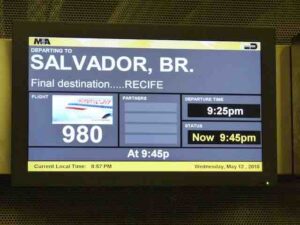
This trip will require us to take six flights coming and going. We were able to get exit row seating on every leg of the trip. However, on the long overnight trip from Miami to Salvador (not El Salvador) we found it advantageous to abandon our exit row seats. We each opted for the chance to lay down over three empty seats and sleep. That worked out very well.
It was more than a hop, skip and jump to get here.
The outbound portion of this trip would be four separate plane rides. First we would go from Los Angeles to Dallas (1,230 miles) then to Miami (1,120 miles), then to Salvador, Brazil (3,880 miles) and finally to our destination of Recife, Brazil (403 miles). That’s a total of 6,633 miles………one-way.
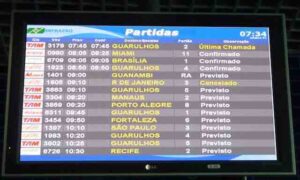
We left our house at 6 a.m. Pacific time Wednesday and landed at 10 a.m. Thursday in Recife, Brazil. That meant we had been traveling for 24 straight hours. If we were going to make that much effort to get here we might as well stay awhile. We’ll be in Recife for six days and five nights.
Day 2 – Thursday

Eu nao falo Portugues (I don’t speak Portuguese)
My advance research told me that Brazilians don’t speak much English. Our first experiences in the airport proved that advice to be true. The official language of Brazil is what else, Portuguese. Of course, we don’t speak Portuguese.
Clearing Brazilian customs was easy. Our $130 per person Brazilian visa certainly “greased the skids” for us. We had some work to do before we could leave the airport.
We would be renting a car. I wasn’t sure if that was the right thing to do our not. Only time will tell. I had rented the most basic car, figuring they might upgrade us. If not, we would probably “get by” with whatever they gave us.
The Budget Rental Car agent spoke very little English. However, he was able to tell me the car didn’t have air-conditioning. The high temperatures during our trip will be 85-90 degrees Fahrenheit. The average low is only 75 degrees. There is also heavy-duty humidity. Think Atlanta in the summer and you have it. We would need air-conditioning.

Que tal um upgrade? (How about an upgrade?)
Despite the language barrier, I was able to explain to the Budget agent’s boss that she should upgrade us to a car with air. She agreed. Now we were talking. She upgraded us from a class A car to a class C car. That turned out to be a four-door Chevrolet “Life”. I had never heard of such a thing. If this car were a two-class upgrade I would hate to see what we had originally reserved. The car has a great air-conditioner, but no power steering or power windows/door locks. It had to have been 25 years since I’ve driven a car without power steering.
We needed some local ‘bucks’.
We needed to exchange U.S. currency in the airport for Brazilian currency. Carol traded in some traveler’s checks and my $90 in U.S. cash for our share of Brazilian Reais. It wasn’t easy pawning off those traveler’s checks but she did it!
I wanted to rent a GPS for our rental car. Unfortunately, they don’t rent them here. Folks, this trip without a GPS unit will be both a great problem and a great adventure. It was supposed to be a 10-minute drive from the airport to our hotel. However………
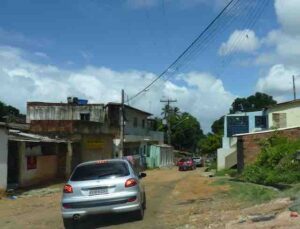
Lost already.
Isn’t there always a “however” in life? The main road was blocked with a “detour” sign. This got us off the beaten path quickly. Soon we were in a little village with dirt/mud roads and all kinds of pedestrian and motorbike/bicycle traffic. Fortunately, we knew our hotel was located on the ocean. As long as we could find the ocean, we’d soon find our hotel.
It was only 11:30 a.m. That was probably too soon to check into the hotel anyway. It was our good fortune that a major shopping center stood as a landmark on the drive to the hotel. We stopped there.
This was a fairly modern indoor shopping center. Other than my pulling into the “out” section of the mall parking lot, we found it easily. Of course, trying to “back out the in” was a challenge. It did teach me how to engage the reverse gear in our 5-speed manual transmission.
Another system we couldn’t figure out.
Once we found the correct way to enter the parking lot, we took a ticket, the gate went up and we were in. We were mainly looking for lunch. Many foreign shopping malls that I have visited have huge food courts. Some of the bigger malls in the Middle East have as many as 50 high quality semi-fast food eateries in their food court. Today’s mall had around twenty choices including McDonalds, Burger King and Subway.
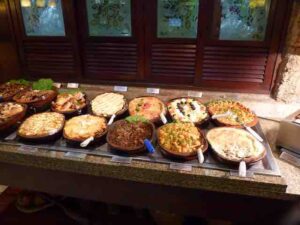
The other 17 choices were all places we had never heard of. There isn’t much English writing on signs or in stores anywhere. Portuguese is not that much like Spanish. It doesn’t sound the same and it doesn’t read the same. Oh, my! We were on our own.
We tried to look at food pictures and the food that was actually on display to pick somewhere for lunch. We finally decided on a restaurant that offered a buffet of sorts. There might have been 10-15 warm entrée choices. I’ll bet I could identify no more than five of the dishes! Yes, international travel can be a great adventure.
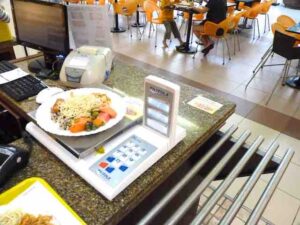
Have you ever paid your restaurant bill based upon how much your food weighed?
When it came time to pay, we noticed something unusual. Customers paid based upon the “weight” of their food. We didn’t worry about the price. We just picked out things that looked good. When we sat down, I converted the cost of lunch into U.S. dollars. It came out to about $24 U.S. That seemed expensive to me. Just down a few food stalls, McDonalds was charging $10-11 U.S. for a “McBrazil” hamburger sandwich with fries and drink. That told me two things. Our lunch was relatively expensive. Moreover, it began to dawn on me that Brazil would be expensive.
I noticed another example of how expensive Brazil was going to be. I recently purchased a new camera. I’ll tell you more about that in my next domestic Trackchasing Report. I bought the camera at Amazon.com. The very same camera in the shopping mall we visited was priced FOUR (4) times higher than what I paid. Wow!
When we finished window-shopping it was time to leave the mall. We took our parking ticket and tried to exit the parking lot. The machine wouldn’t take our ticket and there wasn’t anybody or any place to pay. Since the guard gate wouldn’t let us leave we had to figure out what the problem was. It soon dawned on us that we had to pay INSIDE the mall for our parking. Of course, U.S. shopping malls never charge for parking. It’s little things like this that make traveling in a foreign country both challenging, entertaining and sometimes annoying. You definitely have to bring the right attitude to the trip or you might not have much fun.
When I’m with Carol there is no Motel 6.
Next up was finding our hotel, the Dorisol Recife Grand Hotel. Of course, it was located inside a series of one-way streets that slowed us down for a bit. The Dorisol is a 5-star hotel that came recommended by local Jerry Fisher. I had done my research on this hotel and it passed muster.
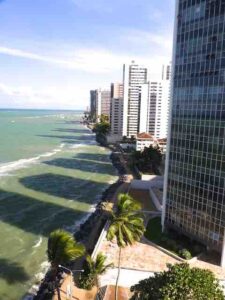
Unlocking the secret hotel room code.
I spend a good deal of time in advance of each trip planning, checking and ultimately acting. One of the tips I got about the Dorisol was stealth but very worthwhile. A previous guest told her “Trip Advisor” followers that rooms on any room numbered “08, 09, 10 or 11” provided the very best ocean views. I can’t emphasize enough the value of proper pre-planning.
Whenever I get information like this I “cut and paste” it into my “Google Calendar” that runs on my Lenovo laptop. Then everything I put into my Google Calendar is wirelessly transferred into my Apple iPhone. It’s a pretty slick operation. Then when I’m standing at the hotel’s front desk, I simple open my iPhone and get the info I need.
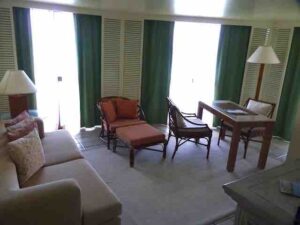
Did having some inside information (like which rooms faced the ocean) and using some fairly simple (although advanced to some) technologies bring a benefit? The answer is a resounding yes. The hotel manager gave us room #909. Our room was a suite! It offered a beautiful living room with sofa and chairs that faced DIRECTLY out to the ocean from the ninth floor. Our bedroom offered a king-sized bed with sweeping views of the Recife coastline. I love it when a plan comes together.
Day 3 – Friday
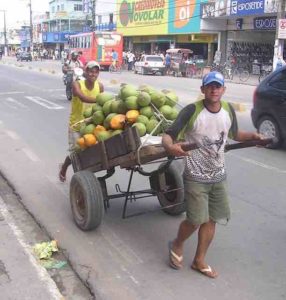
Let the touring begin.
Our first full day in Recife, Brazil’s fourth largest city began with breakfast in the hotel. Our room rate included breakfast. The buffet was extensive. I suspect that, if paid separately, the charge for breakfast would have been about $25 U.S. per person. This made our one bedroom suite room rate with breakfast a fantastic bargain in a country that doesn’t offer many bargains for the U.S. traveler.
We were continuing to find out that most Brazilians don’t speak much English. This makes travel planning inconvenient at best. Since Brazilians speak Portuguese and that’s not much like Spanish. We didn’t understand a thing. Additionally there was very little signage in English. That left Carol and my English resources to be each other!
We were interested in taking a tour of the local area. Last night we had investigated this with the hotel front desk. It was a struggle of sorts to get our point across that we wanted a private tour. Once we did, the hotel staff had a local tour guide give us a call.
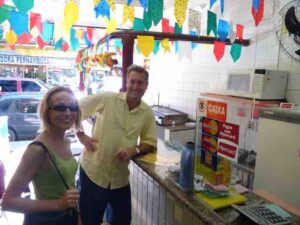
Carlos would save the day.
Soon I was talking to Mr. Carlos Masur of “MasurTur Turismo & Recetivo”. Carolos spoke English well and came highly recommended by the hotel staff. He picked us up at the hotel after breakfast in a modern air-conditioned mini-van. After riding in Recife traffic with Carlos it dawned on me that renting a car here was a bad idea.
Carlos had an unusual tour guide style that I liked very much. First, he would go anywhere we wanted and stop anywhere we wanted for as long as we wanted. What was unusual about his style was this.
He would stop in an area and give us some background on what we were about to see. In the downtown locations he would let us go by ourselves for 2-3 blocks and have us meet him at the end of our walk. This way we could travel at our own pace, stop in shops that appealed and have Carlos waiting to take us to the next part of the tour. This worked out very well.
The weather was hot and humid. That’s about my least favorite kind of weather. At times when we were in the sun it was stifling. Brazil reminded me of some Caribbean countries that we’ve visited. The exterior colors on homes and businesses were often bright reds, greens and blues. Don’t miss the pictures. I think you’ll enjoy them.
Brazil is very expensive.
We soon found that typical souvenirs were priced at 2-4 times what would have made them a good value. We love to “buy stuff” for our loved ones back home. However, the combination of Brazilian inflation recently and a weak U.S. dollar made buying most items a bad idea.
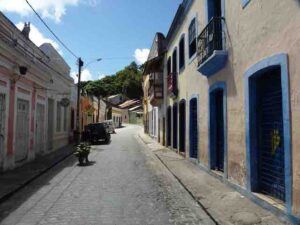
We toured “Olinda” which is a historic city in the Brazilian state of Pernambuco. By the way, Brazil has 26 states. The city was burned by the Dutch during their brief occupation of Brazil back in the 1600s. Today it is a lazy little town with some absolutely gorgeous ocean views.
Don’t miss the Recife ‘old market’ photos.
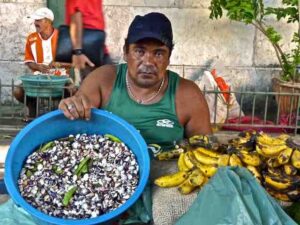
For me the trip’s highlight was a visit to the old market area of Recife. This is an active, fruit, vegetable and fish market. The place is huge. It is crowded with shoppers but almost no tourists. I don’t think that Recife is a popular tourist stop. The market must cover 2-3 square blocks. I’ve never seen so many fruits and veggies that I didn’t recognize. Of course, Carlos was there to explain what everything was and let us try things if we wanted. We saw so much more with him leading us. Often he got us “behind the scenes” that really added to our enjoyment of the Brazilian culture.
In the late afternoon, we still hadn’t stopped for lunch. I asked Carlos if he would take us somewhere to eat that wouldn’t be a “tourist hangout”. He readily obliged. His choice was a restaurant specializing in beef.
All you can eat meat restaurant.
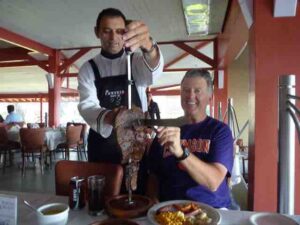
I had never been to a place like this before. These types of restaurants are called “Churrascarias” – all you can eat meat restaurant. The eatery’s interior was modern. Initially, it looked as if they were simply serving a buffet. Except for the meat servings that’s what this place was. Like yesterday’s food court buffet, I didn’t recognize many of the foods being offered. Carol and I filled our plates with side dishes and went back to our table. That’s when the fun began!
Waiters would come by about every minute or two with two-foot long swords carrying one kind of meat or another. This is the Brazilian “gaucho” way of preparing and serving meat. There was filet mignon, garlic beef, prime rib, sausage, chicken and much much more. I had never seen so much meat. If you wanted any, the server would cut off a junk at the table to your liking. Again, having Carlos there to “translate” what we were seeing and eating made all the difference in the world.
With such a late lunch, we didn’t get back to the hotel until nearly 5 p.m. We had been touring all day in hot and humid weather conditions. The previous day we had traveled for 24 straight hours. Now our bellies were full beyond belief. This would have been a good time to call it “an early evening” and go to bed for the night. However, our day was just beginning!
This is the best.
I don’t know if you’ve ever had the opportunity to visit or dine at the home of an international friend. Before this trip we’ve done that in Belgium, Guyana and Scotland. Today, we did it in Brazil.
This entire trip started with an idea from my friend Jerry Fisher. Jerry’s from England but now lives in Brazil with his girlfriend, Katia Maria Spencer. Jerry and Katia invited us to dinner at their apartment this evening.
We had a five o’clock appointment to meet Englishman Jerry in the hotel lobby. We didn’t return from our all-day tour with Carlos until 4:58 p.m.! Yes, today was going to be a full day of activity.
Jerry and I had last seen each other in Buenos Aires, Argentina some 16 months ago. We spent a few minutes “catching up” in the hotel lobby while Carol made a mad dash up to the room to change into her dinner clothes.
When in Rome do as the Romans do.
Jerry has an apartment just a mile or so down the road from our hotel. Given the condition of the sidewalks and road traffic, it wasn’t going to be convenient to walk to his place. “No problem”, Jerry assured us. We would ride one of the public “mini-buses” or “jitneys”.
These are small 12-passenger buses ridden almost exclusively by locals. Folks simply stand by the roadside, wave and the bus stops. It was dark by now. I was surprised at how early it gets dark here. By 5:30 p.m. it is pitch black. Since Recife, Brazil is very near the equator line (8 degrees latitude) that’s the way it is all year. They don’t observe any type of “Daylight Savings Time”.
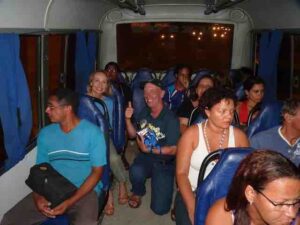
I’m not sure what the local Brazilians riding on the little jitney bus thought of three folks who didn’t look a thing like them or talk a bit like them. There was one seat for Carol. Jerry and I stood as the driver did his best to knock us off our feet. I do think the locals got a kick out of watching us slide from one side of the buses’ interior to the other, if the smiles on their faces were any indication.
When Jerry gave the signal, we told the driver to stop the bus. The fare was only one Real. That’s about 60 cents U.S. I’m sure we’ll ride these little buses again.
Thank goodness for Jerry and Katia.
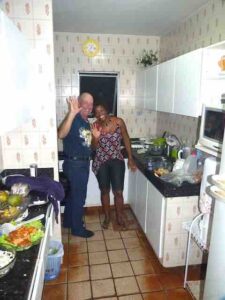
Jerry and his girlfriend “Katia” live in a lovely little apartment right on the beach. It’s actually Katia’s apartment. She’s been living here for nine years and is a native of Brazil.
This was our first opportunity to meet Katia. She was a delight. She grew up in and around Recife. Katia works at one of the local hospitals. Our gift to both Jerry and Katia for the evening was a bottle of South American wine. This wasn’t “any” South American wine. It was a bottle of wine I purchased recently in Chile, hauled back to America and then “rehauled” back to Brazil. I doubt many bottles of wine anywhere had that many frequent flyer miles on them.

Carol had never met Jerry or Katina. I had never met Katina. However, by the evening’s end it was like we were old friends. They had invited us over to their apartment for dinner. I love breaking bread with my international friends. When this can be done in their own homes, it’s “an above and beyond” experience.
Katia was worried but she was also prepared.
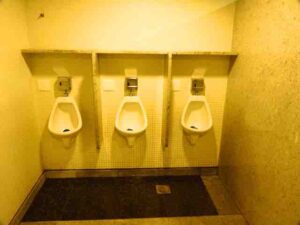
Jerry had told Katina a little bit about my trackchasing hobby. Katina had been checking out my website. She had questions of Jerry. “Why does he take so many pictures of food and men’s bathrooms?” Jerry told me, and Katina confirmed during dinner that she had put an extra amount of time in cleaning their toilet just in case it appeared anywhere on www.randylewis.org! Of course, my policy limits the “urinal” photos to public establishments.
Katina went out of her way to prepare a lovely and delicious three main course meal. We dined on sausage, salmon and roast beef. We had wine, beer, pineapple juice as well as lots of side dishes. The entire meal was concluded with cake and ice cream. Katina is a wonderful cook. We really enjoyed ourselves.
Jerry took us on a tour of their apartment. They had four bedrooms and three bathes. One of the bedrooms is toward the back of the apartment off the kitchen. It is very small. Most Brazilian apartments have this arrangement. The smaller bedroom is typically reserved for a maid. The maid often does all the cleaning, cooking and child care in return for room and board.
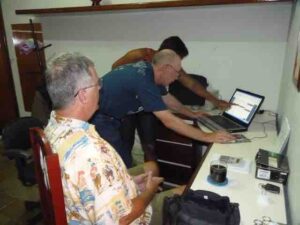
After dinner, we all went in Jerry’s office to check out the Brazilian Formula Truck racing website. Of course, the website was in Portuguese. It was also poorly constructed. Even with Katia being a native Portuguese speaker we couldn’t figure out, for sure, when the race would begin on Sunday. We wrapped up a very fun evening with Jerry and Katia by taking a taxi back to the hotel.
Having dinner and an entire evening in the home of an “international” couple was a trip highlight for certain. We’ll get back together with Katia and Jerry for the race on Sunday. This will be the first race that Katia has ever seen. Everyone has to start somewhere!
From their apartment Carol and I caught a taxi back to the hotel. Recall, the jitney bus ride was R$ 1. The taxis was R$ 9. The driver was wild. We drove down narrow one-way streets at 60-70 M.P.H. All the while pedestrians and people on bikes and mopeds darted in and out of sight. I think I wore out the front floorboard trying to press on the brakes I didn’t have.
Day 4 – Saturday
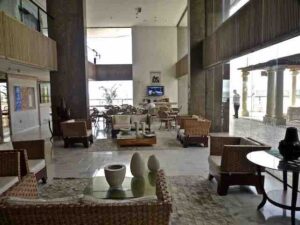
Today there was a major change of plans.
When you’re trying to get the very most out of a trip, logistics are the key. What do I mean by this? I want to see, do and understand as much as I can on one of these trips. However, when I’m not familiar with the language, Portuguese in this case, I have to put myself in a position to overcome that major drawback. Here’s how I went about doing that.
Carol and I had rented a car when we landed at the Recife airport. Brazil is a “drivable” country, although they do operate a little bit on the ragged edge. The car wasn’t very expensive to rent. I figured we could see a lot more driving ourselves than if we took a taxi with a driver who didn’t speak much English.
However, that was before I ran into Mr. Carlos Masur. As detailed from yesterday’s trip, Carlos is a native of Brazil. Of course, his primary language is Portuguese but he speaks English very well. He learned much of his English by being a high school foreign exchange student in Michigan. Following our custom sightseeing tour of Recife and Olinda, I asked Carlos how much he would charge to drive us to the racetrack on Sunday.
It turned out Carlos was already planning to go the race on his own. He quoted me a very reasonable round-trip price. He would do the driving, buy the gas (about $6 U.S. per gallon) and stop whenever and wherever we wanted along the way. This was too good of an offer to pass up.
There was only one sticking point. I didn’t want to have a rental car AND pay for a driver. My “deal” with Carlos hinged on one thing. If I could take my car back to the airport this morning and be charged for only the two days I had the car I would have Carlos drive us to the race. If I had to stick with my original contract for having the car for five days, I would drive us to the race.
I had the power of communication on my side…even though I didn’t speak the language.
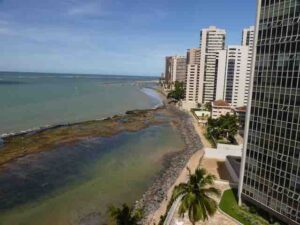
Carlos volunteered to come by at 8:30 a.m. to the hotel and run me on a series of errands at no charge. I followed him to the airport in my car. Despite having driven only 25 kilometers (about 15 miles), the car needed some $15 U.S. in gas. They didn’t give me a full tank when I picked the car up. However, by the time I realized that it was more of a hassle to go back and argue with them.
Once back at the airport Carlos helped negotiate the car’s return. The Budget Rental Car staff speaks very little English. Having Carlos there was a lifesaver. They agreed to let me return the car early and only charge me for the two days I actually had the car. The savings of three days of rental car expense would cover my share of the trip to the racetrack on Sunday. Mission #1 was accomplished.
Next up we wanted to get some better information about tomorrow’s races. Carlos led me over to the “tourist information” office. There he conducted most of the conversation in Portuguese. The tourist information agent brought up the racing website with the details about the race. Of course, the website was entirely in Portuguese. I had viewed this site back home and again last night in Jerry Fisher’s home office.
Overall, the site wasn’t very helpful. It was unclear as to when the race would actually start. One section seemed to say 9 a.m. while another said 2 p.m. Obviously, we didn’t want to come all this way and show up late for the race. Additionally, we didn’t want to get to the track at 9 a.m. in the broiling hot sun and have nothing to do until 2 p.m. if that was when the race started.
Wisconsin ice racing…..in Brazil.
When we finished looking at the Brazilian website, I directed the tourist information agent to www.randylewis.org. This might have been (maybe not!) the first time an official Brazilian tourist information agency had been exposed to trackchasing! The agent and Carlos got a kick out of seeing the YouTube video of Carol and me racing stock cars on a frozen lake in Wisconsin. When Carlos saw me racing a big yellow Chevy Monte Carlo, he asked, “What is that, a taxi cab?” It did look like one.
Everyone needs a race ticket.
From the airport, we were off to a local gas station chain that was selling tickets to the race. This turned out to be a cultural experience as well. One of the station’s employees goes around all day with a tray of water and espresso. These are all complimentary to folks having their tanks filled up!
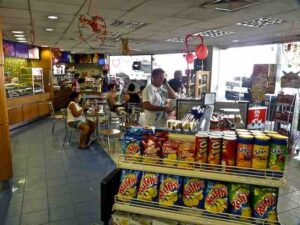
The gas station was selling tickets to the race. Recall, the racetrack is some 145 kilometers (100 miles) from where we are staying in Recife. Again, Carlos “did all the talking” in Portuguese to the gas station clerk. General admission tickets were available for 25 Real. That’s about $15 U.S. There was a special offer when buying the tickets at the station. Ticket buyers received a free hat with the purchase of each ticket.
Last night’s conversation with Jerry Fisher made me think that getting an “upgraded” or “V.I.P.” ticket might be better than settling for general admission. At the station, Carlos found a phone number for the track. He called to inquire about “V.I.P.” tickets. Yes, they were available for 120 Brazilian Real. I had not expected them to quite that expensive. With us not being at the track, it was difficult to tell if it was worth paying $75 U.S. for a V.I.P. ticket or $15 U.S. for a general admission ticket.
I used Carlos’ cell phone to call Jerry Fisher. At the end of our conversation, we agreed to hold off on buying tickets today. We would make our ticket buying decision tomorrow at the track.
Carlos finished driving me and translating for me with a final morning errand at a local Citibank ATM. We needed more Brazilian Real. The trouble was I didn’t have a good idea how MUCH we needed. I made a “wild guess” and the transaction was complete.
Information is the power.
My entire “trackchasing operation” is based upon having maximum information. Information is power. This allows me to make the very best decisions. Typically, all of the machines I use at home (laptop, cell phone, GPS) can answer just about every question I have. I want each and every trip I make to provide as much comfort as possible, not waste a second of time and cost as little as possible. It’s surprising how each one of those technologies supports the overall objective.
However, in Brazil I didn’t have the use of my laptop (online anyway), my cell phone or my GPS unit. However, I had Carlos. He replaced all of my gadgets…..and maybe more importantly he spoke the language. If you review everything that happened today, it’s easy to see how Carlos really made everything happen. Maybe this simple analogy will sum up his value. He was like living in a home with electricity compared to living in one without electricity. I cannot overstate his value enough.
Sorry, we don’t do English.

Carlos dropped me off at the hotel at noon. Carol was out sunning herself, so I made a trip to the “Super Bom” a local supermarket across the street from the hotel. I have visited several countries where there is not much signage in English or conversation in English. I cannot think of a single country where English is rarer than in Brazil. Nevertheless, I know a can of beer when I see one. I picked up some “guy” food essentials for our hotel fridge and a package of grapes to satisfy Carol. It had been a very productive morning! Don’t miss the pictures.
My next report will tell you all about the race that qualified Brazil as my 41st trackchasing country. I hope you enjoy it.
Thanks for reading about my trackchasing,
Randy Lewis
Alberta’s #1 Trackchaser
Brazilian saying: Cigarette warning: The government is harmful to your health.

TRAVEL DETAILS
AIRPLANE
Los Angeles, CA (LAX) – Dallas, TX (DFW) – 1,230 miles
Dallas, TX (DFW) – Miami, FL (MIA) – 1,120 miles
Miami, FL (MIA) – Salvador, Brazil (SSA) – 3,880 miles
Salvador, Brazil (SSA) – Recife, Brazil (REC) – 403 miles
RENTAL CAR
Guararapes International Airport – trip begins
Recife, Brazil – 6 miles
Guararapes International Airport – 12 miles – trip ends

To be continued………………….
Official end of this RLR – Randy Lewis Racing Trackchaser Report
“BRAZIL….THE RACE…AND MORE TOURING” (part 3 of 3)
BRAZIL – PART 3
Greetings from Caruaru, Brazil
THE COUNTRY LIST
#41!!
RLR – Randy Lewis Racing Lifetime Trackchasing Countries
# 1 – UNITED STATES OF AMERICA – Peoria Speedway (Mt. Hawley, oval) – Track #1, Peoria, Illinois – circa 1954 (age 5)
# 2 – CANADA – Cayuga Speedway (oval) – Track #174, Nelles Corner, Ontario, Canada – July 31, 1988 (Dick Trickle winner)
# 3 – AUSTRALIA – Parramatta City Raceway (oval) – Track #180, Granville, New South Wales, Australia – November 17, 1989 (accompanied by Carol)
# 4 – UNITED KINGDOM – Northhampton International Raceway (oval) – Track #378, Northhampton – June 26, 1999 (accompanied by Carol, Kristy, Jim)
# 5 – NETHERLANDS – Driesum Racetrack (oval) – Track #839, Driesum – May 5, 2005 (accompanied by Roland Vanden Eynde)
# 6 – BELGIUM – Bellekouter oval (oval) – Track #841, Affligem – May 8, 2005 (accompanied by Roland Vanden Eynde)
# 7 – FRANCE – Circuit de Croix en Ternois (road course) – Track #843, Saint-Pol sur-Ternoise – May 8, 2005 (accompanied by Roland Vanden Eynde – 2nd new country in one day!)
# 8 – GERMANY – Nurburgring (road course) – Track #844, Nurburg – May 13, 2005 (accompanied by Carol, Roland Vanden Eynde)
# 9 – NEW ZEALAND – Western Springs Speedway (oval) – Track #1,134, Western Springs – December 26, 2006 (accompanied by Carol)
# 10 – MEXICO – Triovalo Bernardo Obregon (oval) – Track #1,281, Tiajamulco de Zuniga, Jalisco – October 14, 2007 (accompanied by Carol, J.J., Roger Ward)
# 11 – BARBADOS – Bushy Park Racing Circuit (road course) – Track #1,296, Bushy Park – December 9, 2007
# 12 – THAILAND – Bira Circuit (road course) – Track #1,300, Pattaya – January 19, 2008
# 13 – SOUTH AFRICA – Durban Grand Prix (road course) – Track #1,315, Durban, KwaZulu-Natal – February 24, 2008 (accompanied by J.J. and Will Van Horne)
# 14 – JAMAICA – Dover Raceway (road course) – Track #1,322, Brown’s Town St. Ann – March 24, 2008
# 15 – SWEDEN – Sturup Raceway (road course) – Track #1,335, Malmo – May 10, 2008 (accompanied by Carol)
# 16 – DENMARK – Ring Djursland (road course) – Track #1,336, Tirstrup – May 11, 2008 (accompanied by Carol)
# 17 – CZECH REPUBLIC – Automotodrome BRNO (road course) – Track #1,381, Brno – September 13, 2008
# 18 – AUSTRIA – Lambrechten Stock Car Track (road course) – Track #1,382, Lambrechten – September 14, 2008
# 19 – IRELAND – Tipperary International Raceway (oval) – Track #1,388, Rosegreen – October 26, 2008 (Carol and I visited this track earlier in the year)
# 20 – GUYANA – South Dakota Circuit (road course) – Track #1,390, Timehri – November 2, 2008 (accompanied by Carol)
# 21 – CHINA – The Guia Circuit (road course) – Track #1,392, Macau – November 16, 2008 (accompanied by Carol)
# 22 – COSTA RICA – Autodromo La Guacima (road course) – Track #1,398, La Guacima – November 30, 2008
# 23 – ANDORRA – Grandvalira Circuit (road course) – Track #1,404, Port d’Envalira, Andorra – January 17, 2009
# 24 – ARGENTINA – Circuito Efren Chemolli (oval) – Track #1,406, Buenos Aires, Argentina – January 31, 2009 (shared with Jerry Fisher)
# 25 – QATAR – Losail International Circuit (road course) – Track #1,408, Doha, Qatar – February 13, 2009
# 26 – BAHRAIN – Bahrain International Circuit (road course) – Track #1,410, Sakhir, Bahrain – February 27, 2009 (accompanied by Carol)
# 27 – UNITED ARAB EMIRATES – Dubai Autodrome (road course) – Track #1,411, Dubai, United Arab Emirates – February 28, 2009 (accompanied by Carol)
# 28 – COLOMBIA – Autodromo de Tocancipa (road course) – Track #1,415, Tocancipa, Colombia – March 22, 2009
# 29 – SPAIN – Motorland Aragon (road course) – Track #1,416, Alcaniz, Spain – March 28, 2009
# 30 – PORTUGAL – Circuto de Murca (road course) – Track #1,417, Murca, Portugal – March 29, 2009
# 31 – ICELAND – Kapelluhraum (road course) – Track #1,420, Hafnafjorour, Iceland – April 25, 2009 (shared with Will White)
# 32 – HUNGARY – Hungaroring (road course) – Track #1,426, Mogyorod, Hungary – May 8, 2009 (accompanied by Carol)
# 33 – SWITZERLAND – Hock Ybrig (road course) – Track #1,427, Hoch Ybrig, Switzerland – May 9, 2009 (accompanied by Carol)
# 34 – ITALY – Vighizzolo d’Este Stock Car Track (road course) – Track #1,428, Vighizzolo d’Este, Italy – May 10, 2009 (accompanied by Carol)
# 35 – DOMINICAN REPUBLIC – Autodromo Mobil 1 (road course) – Track #1,515, Santo Domingo, Dominican Republic – December 6, 2009 (accompanied by Carol)
# 36 – MALTA – Ta’Qali Race Track (road course) – Track #1,521, Ta’Qali, Malta – February 7, 2010 (accompanied by Carol)
# 37 – FINLAND – Lake Pidisjarvi Ice Track (road course) – Track #1,524, Nivala, Finland – February 20, 2010
# 38 – JAPAN – Suzuka Circuit (road course) – Track #1,530, Suzuka, Japan – March 21, 2010
# 39 – CHILE – Autodromo de Interlomas (road course) – Track #1,531, Temuco, Chile – April 18, 2010
# 40 – MOROCCO – Circuit de Marrakesh (road course) – Track #1,535, Marrakesh, Morocco – May 1, 2010 (accompanied by Carol)
# 41 – BRAZIL – Circuit de Caruaru – Ayrton Senna (road course) – Track #1,540, Caruaru, Brazil – May 16, 2010 (accompanied by Carol, Jerry Fisher and Katia Maria Spencer)
The ‘International Big 5’ standings.
I’ve been hitting the international trail pretty hard over the past three years. During the last 31 months, I have added 32 trackchasing countries to my list. Can you imagine traveling to a different international country every month for nearly three years? I find it to be the most fun. I’m now up to 41 countries where I’ve trackchased. The leading trackchasers in the hobby have only trackchased in a total of 60 different countries. I will continue to search out new international locations, but don’t be surprised if my international travels slow down just a little bit. In the meantime, here are the most current international trackchasing standings.
- Roland Vanden Eynde, Vilvoorde, Belgium – 44
- Randy Lewis, San Clemente, CA, USA – 41
- Will White, Quakertown, PA, USA – 23
- Carol Lewis, San Clemente, CA, USA – 22
- Chris Economaki, Charlotte, NC, USA – 19
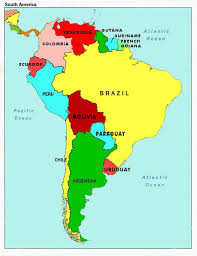
SOUTH AMERICA
A total of 60 different countries have hosted trackchasers. Forty of those countries have been seen by at least two of the “Big 5” international trackchasers. Of course, that means that 20 of the 60 countries have been visited by just one trackchaser. I classify those as “unique” visits.
Up until today, Chris Economaki was the only non-race driver to come to Brazil. Of course, he came here as a newspaperman. Back in 1988, he saw racing at the Autodromo Nelson Piquet in Jacarepaqua. That makes Carol and I the only unpaid trackchasers to ever visit Brazil!
This was my fifth South American country where I have trackchased. The list includes: Argentina, Brazil, Chile, Colombia and Guyana. No other trackchaser has visited more than two South American countries.
TODAY’S HEADLINES
Want to hear some sage retirement advice?..…………..details in “The Objective”.
What does Carol have in common with “Ruby Ridge” or “Waco, Texas”?………………..more in “The Trip – Day 7 – Tuesday”.
Two different cultural views on something as simple as getting a restaurant check……………….more in “The Trip – Day 5 – Sunday”.
THE OBJECTIVE, THE TRIP, THE PEOPLE…AND A WHOLE LOT MORE
The Objective
The best retirement advice.

The main trackchasing objective of this trip was to see a race in Brazil. It wasn’t my idea. It was Jerry Fisher’s. God bless him for that. Trackchasing is taking us all over the world. I read recently the advice from someone on what it takes to have a successful retirement. The person stated, “You have to have some place to go and you have to have something to do”. I guess we’ve got those bases covered.
The Trip
Day 5 – Sunday.
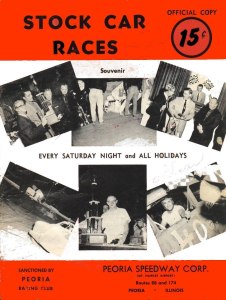
It’s race day!
Yes, it’s RACE DAY!! Despite having seen 1,540 different tracks, I’ve only been able to say “It’s race day” 41 times when seeing a track in a new trackchasing country for the very first time. To be honest, I can’t honestly say if I said, “It’s race day!” when I was around five years old and seeing my first ever race at the old Mt. Hawley version of the Peoria Speedway. Nevertheless, you get my point. Heck, I was 41 years old before I saw my first race outside of the U.S.A.
Like every one of my first-time international visits this one would be quite memorable. Actually it was similar to other international treks for a common reason. The “off-track” experiences were more fun, educational and will stay in my memory bank far longer than what we saw on the racetrack.
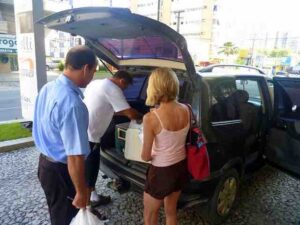
The gang’s all here.
The day started as it does for many of our nation’s NASCAR fans. I made a stop at the local grocery store (Extrabom Supermarcado) to pick up some refreshments. Then, at 8:30 a.m., our guide Carlos Masur came by in his mini-van to pick us up. We traveled just a mile down the road and stopped again. Here we picked up Jerry Fisher and his girlfriend, Katia Spencer. We also med Jerry’s friend “Mike” and his girlfriend. Mike was visiting from England. Mike and his friend would ride up to the track in their own private taxi.
I don’t always do the driving.
Whenever we make these international trips, we make good decisions and bad ones. It’s very difficult to judge the conditions “on the ground” from my office in San Clemente. The best decision of the trip was to hire Carlos to take us to the track today. In the past, I’ve hired drivers or taken public transportation to the track in these countries:
United States (my mom)
Australia (train)
Netherlands (Roland Vanden Eynde)
Belgium (Roland Vanden Eynde)
France (Roland Vanden Eynde)
Germany (Roland Vanden Eynde)
Thailand (taxi driver)
Guyana (taxi driver)
China (ferry/walked)
Argentina (bus/taxi)
United Arab Emirates (hired driver)
Colombia (Juan Alvarez/Ricardo Soler – TC2000 Colombian racing representatives)
Japan (train)
Morocco (taxi/walking)
Brazil (hired driver)
I didn’t realize I had so much help getting to international tracks until I compiled this list.
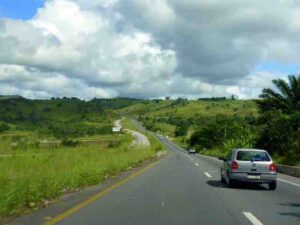
Today’s trip was about 145 kilometers (about 100 miles) one-way. I probably could have found the track and then our hotel afterwards (my words). However, we would have been lost most of the day!! It was difficult finding the track (“Mike’s” taxi had to stop and wait for us because his driver couldn’t locate the Autodromo de Caruaru). After the race it was pure “bedlam”! I don’t use that word lightly. Hiring “Carlos” was the “move of the trip”.
We really didn’t know when the race would even start.
We figured the race would begin at 2 p.m. The Brazilian Formula Truck website did not definitively state that fact. It was only inferred. There were no directions to the track on the website. There also was no race day itinerary. We really didn’t know in advance how many races there would be or when they would be run.
With that in mind we left Recife, where we were staying, early with a plan to get to the track by 11:30 a.m. or so. Of course, we had to make some stops along the way. What’s the use in hiring a driver if you can’t stop when you want, right?
Carlos was the man!
Before I go any further, let me correct myself. Carlos was not only a “hired driver”, he is a “Brazilian guide” as well. His driving skills were impeccable (except maybe when someone cut in front of him!), but his explanations of every little question I had were complete, entertaining and informative. He was “the man” today!
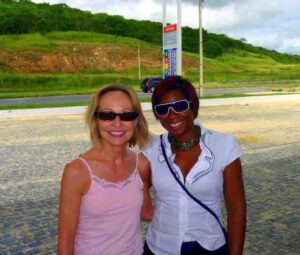
First, we stopped to get some gasoline for the minivan. Carlos’ vehicle used Ethanol. Ethanol in Brazil costs about 35% less than gasoline. A little bit further down the road I noticed we were passing several small villages. I wanted to get a closer look.
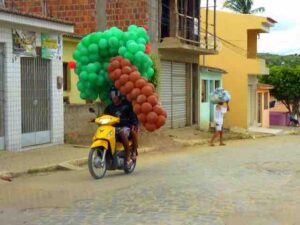
Was this a ‘dodgy’ idea?
Carlos did as I directed. Soon we were bumping up and down on uneven cobblestone roads in a dusty little Brazilian village. Don’t miss the pictures. I detected that Jerry, a U.K. man, thought our diversion was a little on the “dodgy” side and possibly not all that safe. You can’t see Brazil from the motorway! Don’t miss the pictures!
Still a bit further up the road, we stopped at a fresh fruit stand that Carlos was familiar with. When he was a young boy, his family often took holidays in this area. He pointed out two very quaint little hotels with swimming pools, horseback riding and the like from his boyhood travels.
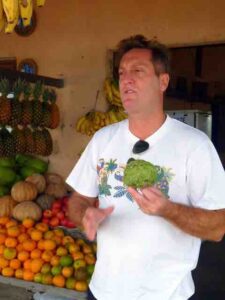
Of course, Carlos could communicate with everyone in Portuguese. Katia could too. This was more than helpful. Portuguese doesn’t sound like any other language spoken anywhere I have ever visited. I guess that’s primarily true because the only other country I have ever visited that spoke this language was Portugal itself. I was only in Portugal for about 12 hours and during that time I was taken good care of by Nena and Rodrigo!
My Apple iPhone weather forecast of five days ago proved to be accurate. The forecast for Caruaru was 81 degrees and no rain. That was cooler that it had been all week in Recife. It did rain lightly for a moment or two on the drive up. This prompted “Trackchasing’s First Mother” to question my weather forecast, as she frequently does. Nevertheless, my iPhone weather app is remarkably accurate. I swear by it. We didn’t get any rain in Caruaru.
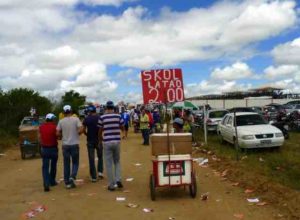
As we neared the racetrack, we noticed people selling tickets along the roadside ala NASCAR. Jerry had been to this track once before to see “pickup trucks”. However, that must have been a local event. Today, Jerry, and everyone else, was amazed at the huge crowd on hand. I’m guessing it was about 10,000 people. That may not seem like much but given the facilities it was a huge crowd.
We were on our own now.
Carlos dropped us off after explaining where he would pick us up after the race. He would spend the afternoon with his girlfriend who lived nearby. He didn’t leave us until he gave me his extra cell phone. This way he and I could contact each other if needed. That was a wonderful plan. Even in Brazil folks “on top of their game” understand that “information is power”.

At this point, the local fans were descending upon the track in great quantities. The walkways were all dirt and loose sand. It looked like it had not rained here in weeks…..and this is the rainy season in Brazil. We still didn’t have tickets. We had decided to wait until we got here to decide on general admission tickets or “V.I.P.” tickets. General admission would cost us R$25 and V.I.P. seats were R$120. That seemed like a huge price difference. We didn’t see V.I.P. seats being sold. We decided to go with general admission seats. In hindsight that was a good decision.
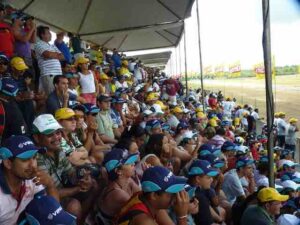
There were several large grandstands that looked to be fully occupied when we bought our tickets. By this time we had met up with “Mike” and his friend who had come to the track in a taxi. Getting six seats together might be difficult in these packed grandstands. With that in mind, Carol and I went in one direction and the rest of the group went in the other. We were lucky enough to find a “covered” grandstand. The cover was only a tarp but it kept four hours worth of sun from “frying us to a frazzle”.
Where are all the geezers?
I don’t know that we saw anyone as old as us all day. What’s the matter with folks our age? Where are they? What do they do with their time? Most of the fans in the grandstand were in their 20s and 30s. They were an energetic bunch. In order to save our seats at least Carol or I had to stay in the grandstand at all times. We would be in the grandstand for more than two hours before the racing got started.
I know where all the M-80 firecrackers were.
The crowd was loud. They blew horns, screamed, yelled, danced…..and blew off firecrackers. Each time a firecracker (probably an M-80) went off the crowd yelled its approval. Of course, that only encouraged more firecrackers. Carol was actually hit in the leg with debris from one of the explosions! Now I feel I am qualified to see a race in Iraq should they have one anytime soon.
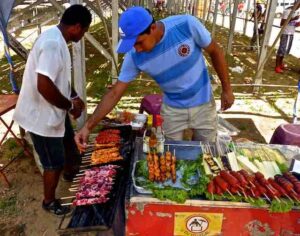
By now we were getting hungry. Carol sent me on a “hunting and gathering” mission. It’s what I’m good at. While walking behind one grandstand a huge explosion went off. I could feel the concussive effect from where I stood. Two car alarms went off near where I was standing. Yep! I can’t wait to go trackchasing in Iraq!
All of the refreshments today were sold from small BBQ grills. There were no formal “concession stands”. There was a wide selection of meats being sold. Everything was “served on a stick”. This included hot dogs, chicken and a cheese stick. I bought some of each and returned to Carol in the grandstand. Yes, I felt like a caveman doing his thing. The melted mozzarella cheese stick was so good I had a second later in the day.
Vendors came through the stands selling food and drink as well. The most unusual offering was a man selling fresh shrimp. Today was my 1,540th lifetime track. I had never seen a man carting a huge bowl of shrimp on his head in the stands before!
What good was a great P.A. system when all of the announcements were in Portuguese?
The P.A. system was robust. However, 100% of the continual announcements were in Portuguese as you might expect. Other than the folks who came with us today, we didn’t see or hear any other English speaking fans all day. Carlos says that Recife gets “no American tourists”. He should know since that’s his business.
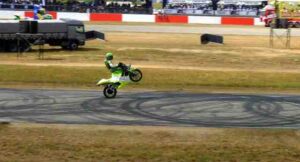
There was a good deal of “pre-race” entertainment. This included motorcyclists doing all kinds of “wheelies” and other stunts. Several “Formula Truck Show” drivers took special “Mack-type” truck cabs and did burnouts and spinouts. Probably the most spectacular was a skateboarder who hung onto the back of a motorcycle until their speed reached about 50 M.P.H. At that point the skateboarder let go of the cycle and “was on his own”. All of this went on for about an hour.
Without any P.A. announcements in English, we had no idea when the race would start, what the racing program was going to be or how long the race would last. So….we waited. The website seemed to indicate the race might begin at 2 p.m. After some preliminaries, the race did begin at 2:15 p.m.
Don’t miss the video.
Today I would see a type of truck racing I had never seen in my previous 1,539 tracks. What we saw is called “Brazilian Formula Truck” racing. Check out this YouTube video to see what I’m talking about. It’s pretty cool!
http://www.youtube.com/watch?v=u8cdbPKwQYg
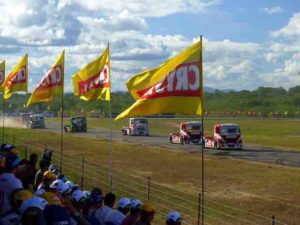
Imagine the 18-wheeler trucks you see on the highway every day. Take away the trailer and you are left with the truck cab. That’s what they raced today. Trucks of all makes including Volkswagen, Ford, Mercedes and others were represented. Twenty-four trucks took the green flag on the 2-mile asphalt road course. We could see 60-70% of the track, although some of our views were from a long distance.
We had a great view to the two longest “straights” on the course, both of which were parallel to each other. One straight was within 75 yards of us. The other straightaway sat directly in front of the paddock area. The race winner, in a VW truck, led every lap for the win. However the winner was hotly pursued by a Ford truck that smoked badly during the entire race.
There were a couple of yellow flag periods for spins in the turns of the track. The turns were off in the distance from our viewing point. At precisely one hour after the green flag flew, the checkered flag was shown. I don’t know if the race was scheduled for a fixed number of laps or a fixed amount of time. I suspect it was the latter.

The environment, the crowd, the noise and the food far overshadowed the race. That’s O.K. It’s all part of the “show”. Don’t miss the pictures. Next up we faced one of our more daunting tasks. We needed to find Carlos.
Many of the NASCAR stock car events I’ve seen have attracted huge crowds. For a few years back in the 80s, Carol and I were season ticket holders for the fall North Wilkesboro, North Carolina race. The traffic getting out of there was so bad that we would simply have a “cook-out” until the traffic cleared. Normally, we would be wrapping up our North Carolina “supper” in about three hours. Traffic had normally cleared out enough by then to let us move out of the North Wilkesboro Speedway with a minimum of delay.
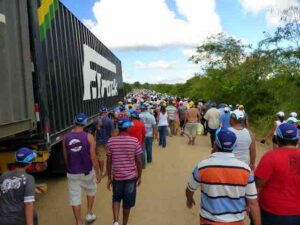
Today’s crowd reminded me of those NASCAR scenes. There weren’t as many people but then the facilities today were not nearly as good as the less than stellar roadways around North Wilkesboro. First, we had to walk with about 10,000 other people about a mile to where the parking area was.
Now we had to get out of here.
We had agreed to meet Carlos at a specific point after the race ended near where he had dropped us off. However, by this point there were either people, cars or people on motorbikes occupying almost every square inch of ground for as far as the eye could see.
Surprisingly, we found Jerry, “Mike”, and their mates almost immediately at the planned meeting point. Mike’s taxi driver was there but we didn’t see Carlos. I had spoken to Carlos mid-race on our cell phones. I called him again. He was nearby and we soon reunited. That’s when the fun began.

No, driving in this crowd was not for the faint-hearted.
Driving in outbound Brazilian race traffic is not for the faint-hearted. I’m not sure it’s much good for someone with a healthy heart! There’s a lot more “take” than there is “give”. Fortunately, Carlos is not afraid to stick the nose of his mini-van into the fray. The traffic was multiple lanes wide with cars, motorcycles and people pointing in all directions. It was a real “free-for-all”! Nevertheless, the entire day was presided over with a beautiful Brazilian rainbow.
Did they really need M-16 machine guns?
There was more “police presence” at today’s event than I can ever recall seeing. Some of the police had M-16 semi-automatic (maybe automatic) machine guns! Yep! It sure gave us a secure feeling.
Could I have found this track and then found my way home? Of course I could have. Would it have been a major hassle? You betcha! Carlos got us out of there in good shape. The idea of the day was acquiring his services.
It gets dark in this part of Brazil at just past 5 p.m. Most of our drive after the race was in the dark. Jerry and Katia slept much of the way back. I rode in the front seat and peppered Carlos with questions about Brazil and its customs. With his good English and insight into his native country I learned a lot.
On the ride back to the hotel I did ask Jerry if he would ever come back for this racing program. His answer was short, “No”. Sounds like a “trackchaser” is being born here. Jerry did tell me his overall track total is in the “80s”. He’s interested in joining the trackchasing group under the “I’m from a foreign country amnesty program”. Whatever works. Jerry did say about the only way he’s going to reach 100 tracks (the amnesty minimum) would be to visit the United States. He could probably get the tracks he needs in five or six days under the right conditions.
It was time for another very unique local Brazilian dinner.
We got back into the outskirts of Recife at a little past 6 p.m. I had invited Jerry and Katia to join us for dinner. However, they had been in the sun all afternoon and were too tired to stay out later. Katia had to get up for work early tomorrow morning. Therefore, Carlos, Carol and I headed out for the evening meal.
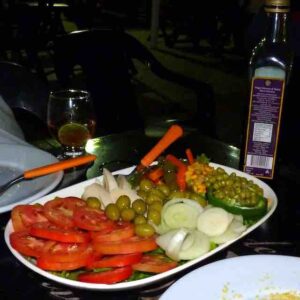
I gave Carlos my preferences for a dinner spot. I told him I wanted to eat at a place where no tourists ever frequent. I wanted the place to be casual and offer good Brazilian food. Of course, Carlos had just the spot in mind. It was a small family steakhouse where he’s visited many times with his family.
This was an outdoor eatery. Since it doesn’t fall much below 75 degrees Fahrenheit for the low temperature of the day, eating outside was very comfortable. Carlos hosted a birthday party for his son here recently. It was nice to have him order for us in Portuguese. When I wanted some extra service, it was easy to get with Carlos acting as the interpreter.
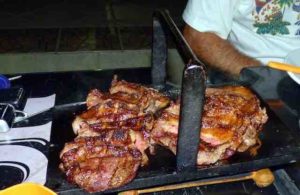
We placed an order for “steak” and “fish” as well as “salad”. Don’t miss the pictures!! The food was delicious and plentiful. Even though we were stuffed, I asked Carlos to order us a Brazilian dessert that was unique to Brazil. That turned out to be a serving of “Carlota”. This was a combination of cinnamon sugar, fried bananas and fried mozzarella cheese. Yes, it’s the unusual that keeps us coming back to these foreign countries.
Two different points of view.
In Brazil, as in Europe, the restaurant server does not bring the check until you ask for it. Diners can sit in their chairs for hours and the check will never be delivered. This often bugs Carol and me. When we finish our meal we often want to get going. We get annoyed when the server is “slow” in bringing the check.
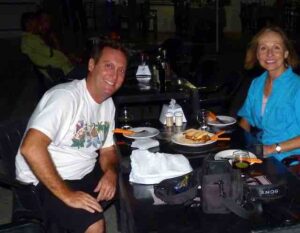
Carlos offered us another point of view about getting the check. He told us that he is annoyed when the server brings the check before he requests it. He sees this as the restaurant trying to “push” him out before he’s ready to go. Carlos says, “I’m the customer and I should be able to sit at my table until I want to leave”. Of course a cultural difference like this is what wars are made from. As I travel the world, I see many examples on how two different cultures look at the very same thing in totally different ways. When one thinks he/she can convince the other to change their cultural beliefs…..the war can’t be too far off.
After dinner, Carlos drove us back to the hotel. I shook hands and Carol gave Carlos a big hug. We were lucky to have the foresight a few days ago to take a private tour. That morphed into getting all kinds of help at the airport, getting race tickets and finding the right kind of bank ATM. Then having Carlos take us to the races was the cherry on top of our vacation sundae. We bade farewell to Carlos on the next to last night of our Brazilian adventure.
Day 6 – Monday.
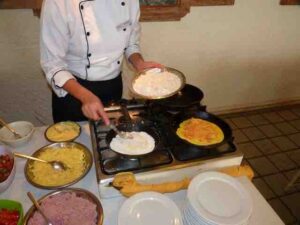
Ever had a tapioca omelet?
We slept in late and then had breakfast at the Dorisol Recife Grand Hotel buffet. Acting on Carlos’ recommendation I tried a “tapioca omelet”. The tapioca looked like table salt in a bowl. The chef sprinkled the tapioca in the serving pan as an egg omelet would be prepared. Then coconut, cheese and a sweet “icing” type concoction was added. It was fantastic!
Today is the last full day for us in Brazil. I had debated during the planning phase of this trip about going home today or tomorrow. I’m always concerned about having enough non-race time when I visit a foreign country. In hindsight it probably would have been better to leave for home today. There didn’t seem like there was much more to see in the area.
I must tell you that I am not a fan of hot and humid weather. This trip has offered 100% hot and humid weather! Actually our race day in Caruaru was the best of the entire trip. It was a bit cooler and we were under shade during the entire race. Other than that it’s been in the high 80s with humidity to match. Once you hit the outside it seems like the shower you took ten minutes ago never happened. Even our hotel air-conditioning can’t soak up the humidity.
Lost in the big city.
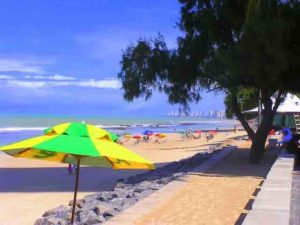
Our first outdoor activity was to visit the beaches at Boa Viagem. Recife has some very nice beaches. However, the best beaches are about two miles to the south of our hotel. The beach in front of the Dorisol Hotel isn’t good at all. I figured that Carol and I would hop on one of the little “jitney” buses and be at the beach in no time. It didn’t exactly work out that way!
These small municipal buses have a driver and room for about 12 passengers to sit. They also have a fellow who stands by the door of the bus. He collects the passenger fares when folks are ready to leave the bus. He also calls out the buses destination to prospective riders along the road as the bus moves along. A simple wave from a potential customer is all that’s need to get the bus to stop. Fares are low. We paid just one Rial.
I figured we would ride the bus straight north for two miles and get off at the beach. Of course, there was no English being spoken and nothing was written in English. Nevertheless, I thought I had the system figured out. Wrong! Soon the bus turned left into the central part of the city. It didn’t look like a very good part of town.
I tapped on the “bus barker’s” shoulder to ask why we weren’t headed toward the beach. Of course, I got back nothing that I could understand. It seemed best to get off the bus. However, two white folks getting off in this part of town, was more than noticeable. Last night both Jerry Fisher and our guide Carlos had regaled me with stories about muggings and thefts. They kept reminding me that my new camera and I could soon be separated if I made one wrong move. Of course, Carol had been party to this somewhat alarming conversation. It took us about ten minutes to hail a cab and hightail it out of there. It’s impossible to understand if our fear was justified or not.
Sharks!
From there we were off to the beach. When the tide is out, the flat part of the beach is a good 50-75 yards wide. There is also a natural reef that allows swimmers plenty of room to play in crystal clear water. The reef is a good thing. On the ocean side of the reef sharks are abundant. There are many shark signs up and down the beach. Over the weekend, this beach had been packed. Today being Monday, there wasn’t much happening.
Following a brief stop at the beach, it was off to the Recife Shopping Mall. This mall is the biggest in town. We were looking for gifts for our loved ones back home. I remember as a boy my grandparents would normally make one overnight trip a year to Chicago (about three hours away). They always had a small gift for me in their suitcases upon their return. I really looked forward to those gifts.
It was just too darned expensive.
We’ve been doing a lot of international travel during the past three years. I fear our gift giving has become somewhat of a “ho-hum” affair considering the frequency of our efforts. Shopping was majorly affected by the price of goods in Brazil. I already mentioned that I saw the same model camera that I just bought for four times the price I paid at Amazon. Most of the kid’s clothes, toys or other souvenirs were 2-3 times what we pay in the United States.
I think of myself as being pretty good with the understanding of economics. Here is something I don’t understand. Folks in the United States have the best standard of living of any of the 41 trackchasing countries I have visited by far. If that is true, how come “stuff” has been more expensive in about 35 of those countries than it would be in the U.S.? If we can’t afford it how can the people living in the local country? I just don’t understand it.
Let’s go to the movies…..in Brazil.
For the second time on this trip, we decided to watch a movie in the shopping mall. Each of the two malls we had visited has ten screens. However, they are not showing ten movies. Some of the films are dubbed. This abbreviation (DUB) indicates the normally English language movie has the actors speaking in Portuguese. Other films have the actors speaking English with Portuguese subtitles. Still other movies are totally in Portuguese without any subtitles.
Of course, none of this is immediately obvious to English speaking customers. The movie ticket sellers don’t speak enough English to even tell us what language the movies are in. We resorted to asking (begging?) folks waiting to buy their tickets what movies might be in English. Everywhere we went folks were willing to help, it’s just that most of the time they just didn’t speak any English.
We ended up eating lunch at the mall’s food court. After eating mainly local food I was itching for a hamburger. Even back in the U.S. I probably don’t eat but one or two hamburgers each month. The 20 restaurant food court featured a McDonalds and a Burger King. However, I don’t like to eat at those chains when I’m traveling internationally.

I ended up choosing “Bob’s Burgers”. Of course, it was nearly identical to Mickey D’s and BK, but it wasn’t them. Maybe “Bob’s Burgers” is a big burger chain in England or somewhere else. Their triple cheeseburger didn’t really taste like American hamburger. Nevertheless, it was acceptable.
Out of ten movie screens the best we could do was a “Nightmare on Elm Street” sequel. Robin Hood was playing on three screens (we saw that two days ago) in multiple language formats. The various other films didn’t have a good starting time or the right language. Doing something as simple as seeing a movie isn’t very “simple” or all that entertaining when it takes such effort to make it happen.
The movie was packed with younger people. Several near the back of the theatre were rowdy and started throwing things during the showing. They might have throwing a liquid of some sort. This didn’t sit well with the crowd as you might expect. Soon security was called and the lights went up even though they continued with the movie. Patrons from all over the theatre shouted in Portuguese as they tried to identify the guilty. One of the guards stayed in the theatre and the movie resumed with a much more well behaved audience. After seeing the young Brazilians at yesterday’s race and in the movie theatre, I will say this. They are “active” bunch. I’m not sure I would want to attend a Brazilian soccer match!

Following the movie we tried to do some more shopping. However, the exorbitant prices made that a poor economic choice. We were just a mile or so from our hotel. We had walked this distance earlier in the trip during the day. It was nighttime now. We had been told the area wasn’t that safe so we chose a cab. Wrong choice!
Walk and get mugged or drive and die of bus fumes?
Our cab did not have air-conditioning. The traffic was as bad as it had been getting out of yesterday’s race. Maybe worse! We sweated in that cab for the better part of the mile we had to cover. The ride to that point took us 45 minutes!!! I couldn’t take it anymore. I paid the driver the metered fare of 14 Reais (about $10 U.S.) and we walked the rest of the way. I would rather be mugged than sit in the cab breathing bus fumes all night.
Once back at the hotel it was time to pack our bags. This was one of the few trips where it made sense to check bags on the airplane. It was too bad that we hadn’t been able to add many Brazilian remembrances to our gift-giving program.
Day 7 – Tuesday.
It’s getaway day.
Today was “getaway” day. We had been in Brazil for six days. We had fun, met some great people and saw some interesting sights. However, all good things must come to an end. There are still a lot of countries where I have not trackchased. They will get their “day in the sun” in good time.
If you’re one of those fine folks I’ve met on an international trackchasing trip, let me hear from you. Better yet, keep me posted about upcoming races in countries near you where I haven’t trackchased. I’ll be indebted to you for your generosity.
We grabbed a taxi for the Recife airport. Cab fare was about R$26. Drive time from the Dorisol hotel was less than 15 minutes. The drive took us along the Boa Viagem beaches for a good mile or two.
Today’s flight would first take us to Miami and then onto Los Angeles. We were leaving Recife at 10:50 a.m. (6:50 a.m. San Clemente time). If all went well we would pull into our driveway at about 1 a.m. San Clemente time. That would “only be 18 hours to travel”. For me, that’s a piece of cake!
The airport was top notch.
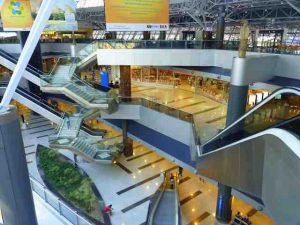
The Recife airport is one of the very best “smaller airports” I’ve ever seen. It’s brand new. There are three separate levels all created in a “space-age” type of architecture. There are plenty of shops and eating places.
We arrived at the Recife airport one hour and 25 minutes before our scheduled departure time. The American Airlines counter agent told us we were “late”. I wanted to tell her that was “BS” but she didn’t seem like the kind of person who wanted any “attitude” from anyone but herself. She told us the flight would be “closed” one hour before departure. Whatever.
Yes men stay.
Getting through airport security was a “trip” for Carol. I breezed right through. Long ago, I learned that “Yes men stay”. That theory applied to clearing airport security works too. I go with the flow for whatever the TSA agents want me to do.
Give me freedom or give me death.
Carol, on the other hand, takes a slightly different approach. In another life she easily could have been one of the folks in a gun battle standoff with “government authorities” at Ruby Ridge or Waco, Texas. She doesn’t want the government in any aspect of her life. I, on still the other hand, am willing to give up some of my civil liberties in order to keep idiots from trying to blow up my airplane.
Carol was “hassled” or “screened” depending upon your point of view when she went through airport security. They went through her stuff with a “fine tooth comb” just like I do with her stuff at home. Of course, they found a couple of plastic forks and a metal tweezer that didn’t pass muster. She was probably delayed some 10-15 minutes. All the while I relaxed in a cushy chair knowing that my “Yes men stay” theory had worked again.
By this time Carol was about ready to “rip the lady’s head off” that was causing her trouble. I could see from her body language that she didn’t think she was being treated in a “fair and balanced” manner. For a while I thought she might not be boarding the plane today. Finally cooler heads prevailed and we were permitted to leave Brazil. From that point the trip went smoother. We relaxed in our extra legroom coach seats and were soon landing in Miami after about eight hours of flying.
Editor’s note:
You should know that I “cleared” the above commentary with Carol before posting it on the worldwide web. Yes, the “Yes men stay” works in ALL kinds of situation. Carol wanted me to tell you that I got lost in the Recife airport and had a hard time finding the American Airlines check-in point and our departing gate. This cut down on her shopping time. She also told me, “You kindly left out all of those things didn’t you. Maybe I should be writing these reports”. Of course, my reports are always “fair and balanced” so Carol gets her say too!
We made it back home safe and sound.
We arrived back in San Clemente at nearly 1 a.m. on Wednesday morning. That would be 5 a.m. Brazilian time, but then who was counting at that point. We had a wonderful time. We always have a wonderful time because we WANT too. Attitude makes all the difference in the world.
Thanks for reading about my trackchasing,
Randy Lewis
Alberta’s #1 Trackchaser
Brazilian saying: Never promise a poor person and never owe a rich one.
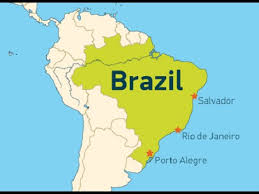
TRAVEL DETAILS
AIRPLANE
Los Angeles, CA (LAX) – Dallas, TX (DFW) – 1,230 miles
Dallas, TX (DFW) – Miami, FL (MIA) – 1,120 miles
Miami, FL (MIA) – Salvador, Brazil (SSA) – 3,880 miles
Salvador, Brazil (SSA) – Recife, Brazil (REC) – 403 miles
AIRPLANE
Recife, Brazil (REC) – Miami, FL (MIA) – 3,840 miles
Miami, FL (MIA) – Los Angeles, CA (LAX) – 2,340 miles
Total Air miles – 12,813 (6 flights)
Total Rental Car miles – 15 (1 aborted rental car)
Total Hired Driver miles – 242
Total auto, air miles, miles traveled on this trip – 13,070 miles
TRACK ADMISSION PRICES:
Autodromo de Caruaru – R$ 25 (about $15 U.S.)
Total racetrack admissions for the trip – $72
LIFETIME TRACKCHASER COMPARISONS
There are no trackchasers currently within 200 tracks of my lifetime total.
- Randy Lewis, San Clemente, California – 1,540
- Ed Esser, Madison, Wisconsin – 1,273
- Guy “The Kid” Smith, Effort, Pennsylvania – 1,264
Official end of RLR – Randy Lewis Racing Trackchaser Report
The Entire Brazilian trip….don’t miss it.

